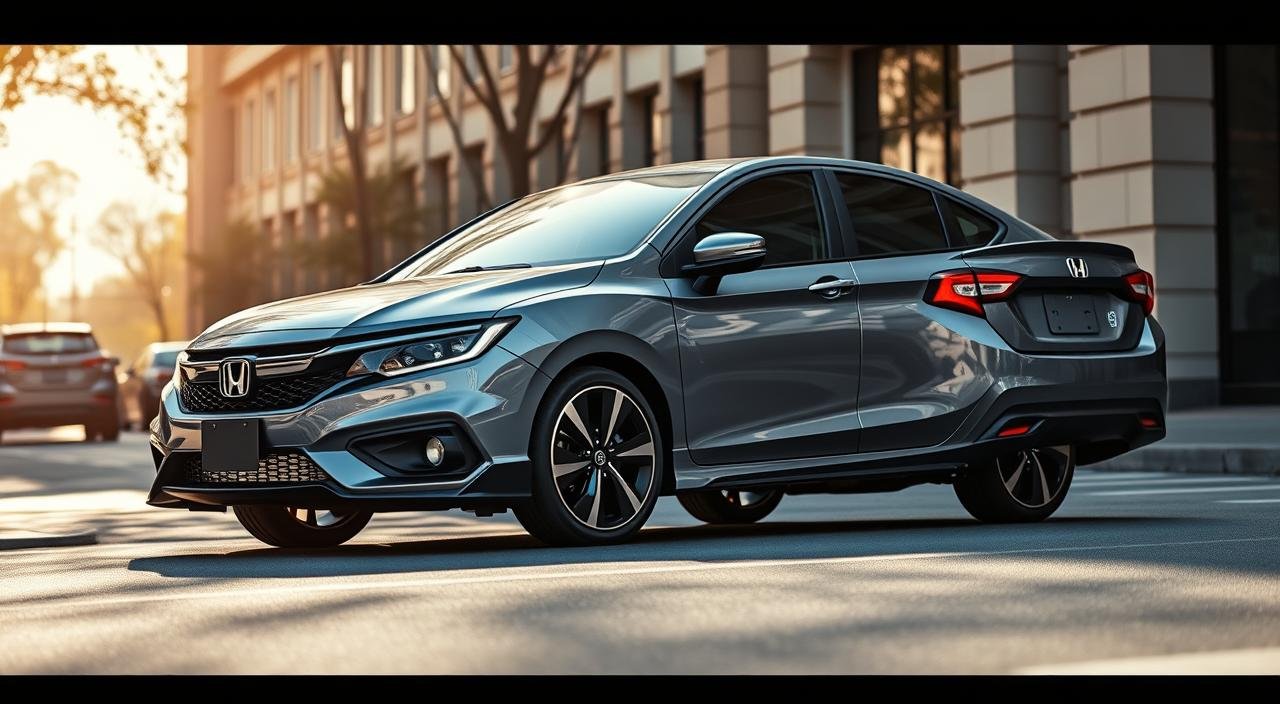
Jun
Can a few cosmetic tweaks and added features turn a practical sedan into a real sports machine? Honda Cars India thinks so with their latest City Sport Edition, priced at ₹14.89 lakh (ex-showroom). This limited-edition Honda sedan hit the Indian market on June 22, 2025. It promises athletic flair without losing comfort.
The Sport Edition is Honda’s answer for customers wanting more visual excitement from their mid-size sedan. While the mechanical foundation stays the same as the standard City, this sport trim adds exclusive design elements and premium features. Deliveries will start soon across Honda dealerships nationwide.
This new variant sits between the regular City variants and performance-focused sedans. The Sport Edition is for buyers who love sporty looks but need practical daily transport. With its premium price and limited availability, Honda aims to create exclusivity and test market response to sportier City variants.
Key Takeaways
- Honda City Sport Edition launches at ₹14.89 lakh (ex-showroom) in India
- Limited-edition model features cosmetic upgrades and additional features
- Mechanical components remain identical to standard City variants
- Deliveries scheduled to begin shortly at Honda dealerships
- Sport trim targets customers seeking athletic appearance with comfort
- Premium pricing reflects exclusive positioning in City lineup
Overview of the Honda City Sport
The Honda City Sport edition is now available in India for ₹14.89 lakh. It sits between the standard City and premium rivals. It offers sporty looks and unique interior touches.
It’s built on the City’s successful platform. This aims to attract young buyers who want style without losing practicality.
Key Features and Specifications
The City Sport has features like the V CVT trim. It comes with an 8-inch touchscreen, wireless Android Auto, and Apple CarPlay. It also has projector headlamps, automatic climate control, and a push-button start.
It includes rear parking sensors and connected car tech. The instrument cluster has a 4.2-inch TFT display.
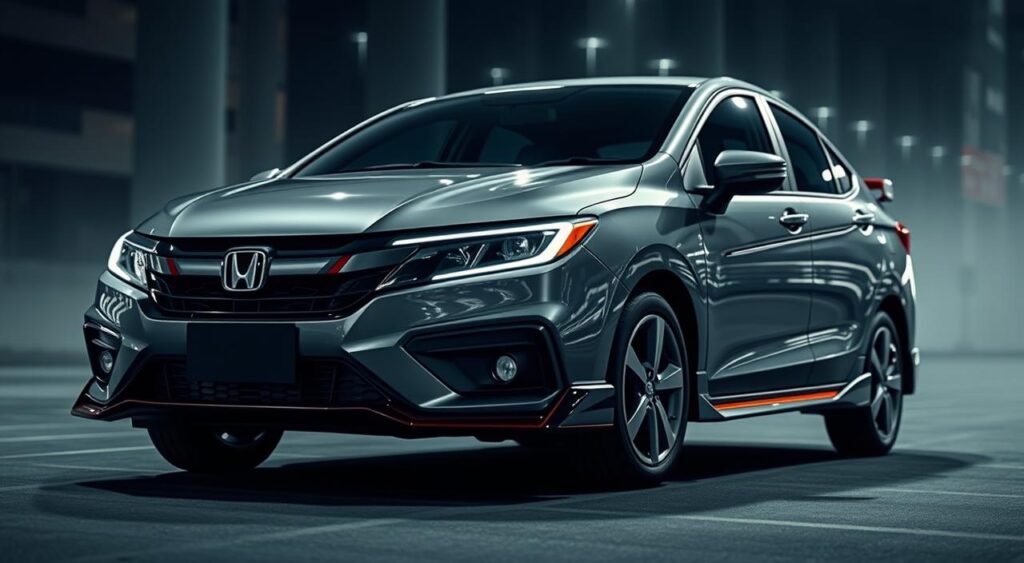
Engine and Performance
It has a 1.5-liter engine that makes 121 bhp and 145 Nm of torque. It’s paired with a CVT automatic transmission. The engine and transmission work well for city and highway driving.
The CVT ensures smooth gear changes. This makes the car fuel-efficient and refined, even if it’s not the sportiest.
Design and Aesthetics
The City Sport has unique design enhancements. Its all-black interior has red stitching. Gloss black accents the air vents, and there’s dark roof liner and ambient lighting.
Outside, it has a glossy black grille and boot-lid spoiler. It also has black alloy wheels and Sport badging. It’s available in Radiant Red Metallic, Platinum White Pearl, and Meteoroid Gray Metallic.
| Feature Category | City Sport Specifications |
|---|---|
| Engine | 1.5L Petrol, 121 bhp |
| Transmission | CVT Automatic Only |
| Interior Theme | All-Black with Red Stitching |
| Infotainment | 8-inch Touchscreen |
| Special Features | 7-Color Ambient Lighting |
The City Sport focuses on looks, not mechanical changes. Its sporty appearance makes driving more engaging. It offers a premium feel that justifies its price.
Comparison with Honda City Variants
The Honda City Sport starts at ₹14.89 lakh, making it a unique choice. It falls between the standard and premium models. To understand its place, we need to look at prices, features, and who buys each model.
Price Differences
The Sport Edition is ₹49,000 more than the V CVT, priced at ₹14.30 lakh. This small increase is for its special looks. The ZX CVT, the top model, costs ₹16.55 lakh, so the Sport is more affordable by ₹1.66 lakh.

For those on a tight budget, the SV manual starts at ₹12.28 lakh. The VX trim is in the middle, costing ₹14.12 lakh for manual and ₹15.37 lakh for CVT.
Feature Set Analysis
The Sport Edition has more than the V CVT. It adds sporty looks and a better interior feel. It keeps the key comforts and conveniences of the V model.
Higher models, like the ZX, have Honda Sensing ADAS. This includes:
- Adaptive cruise control
- Automatic emergency braking
- Lane-keep assist and departure warning
- High beam assist
- Lead vehicle departure alert
Target Audience
The Sport Edition is for young professionals and those who love style. It offers a mix of looks and comfort at a good price. It’s perfect for those who want something more than basic but less than top-of-the-line.
Driving Experience of Honda City Sport
The Honda City Sport offers a smooth ride, focusing on comfort. It doesn’t feel as sporty as its name suggests. The 1,498cc engine gives enough power for city and highway driving.
Handling and Ride Comfort
The ride is soft and smooth, handling bumps well. It’s designed for comfort, not sporty handling. The CVT transmission makes city driving easy. You can adjust the driver’s seat and enjoy fresh air thanks to the air purifier.

Sporty Enhancements Over Standard Model
The City Sport looks sporty but doesn’t drive differently. It has black and red touches but no mechanical changes. Fuel efficiency and boot space stay the same as other models.
| Feature | Standard City | City Sport |
|---|---|---|
| Engine Output | 119.35 bhp | 119.35 bhp |
| Torque | 145 Nm | 145 Nm |
| Transmission | Manual/CVT | CVT Only |
| Fuel Efficiency | 18.4 kmpl (CVT) | 18.4 kmpl |
| Visual Elements | Chrome accents | Black accents |
Voice commands make driving easier, letting you control things without your hands. Honda chose automatic transmission for those who prefer convenience over engagement.
Market Positioning and Competitors
The Honda City Sport is a new entry in the mid-size sedan market. It costs ₹14.89 lakh and offers style and exclusivity at a lower price. To understand its place, we need to compare it with its competitors.
Comparison with Rivals in the Segment
The City Sport competes with well-known brands in India. Each has its own strengths that buyers consider when choosing.
| Model | Price (₹ Lakh) | Key Features | Engine Type |
|---|---|---|---|
| Honda City Sport | 14.89 | Sporty body kit, touchscreen, automatic climate control | 1.5L Petrol |
| Hyundai Verna SX Opt IVT | 16.36 | Ventilated seats, wireless charging, ADAS | 1.5L Turbo Petrol |
| Skoda Slavia Monte Carlo AT | 16.49 | Sport suspension, ambient lighting, sunroof | 1.0L TSI |
| Honda Amaze VX Elite CVT | 9.96 | LED headlamps, cruise control, paddle shifters | 1.2L Petrol |

Customer Expectations and Preferences
Today’s sedan buyers want more than just a car. The City Sport offers visual differentiation with its unique body kit and sporty look. It also comes with features like a multi-function steering wheel and alloy wheels.
Its limited-edition status adds emotional value. It appeals to those who want to be different without spending too much. This makes it a great choice for those who value style and practicality.
Customer Feedback and Reception
The Honda City Sport has caught the attention of many in India. Young professionals are drawn to its sport trim and price of ₹14.89 lakh. Yet, opinions are mixed on if the design is worth the sporty label.
Initial Reviews and Critiques
Those who’ve bought the Honda City Sport love its looks and drive. The sport trim’s blacked-out parts and special wheels get a lot of praise. Reviewers also say it keeps the City’s roomy interior and smooth ride.

- The build quality is top-notch in the City series
- It gets 15-16 kmpl on highways over 80 kmph
- The Honda Connect app works well most of the time
- Some want ventilated seats and better infotainment
Social Media Reactions
Online, people are excited about the sport trim’s looks. Instagram and Twitter are full of photos and comments about the Honda City Sport. There’s a lot of talk about if it’s truly sporty or just looks that way.
| Platform | Common Feedback Theme | User Sentiment |
|---|---|---|
| Visual Appeal | Highly Positive | |
| Price Value Discussion | Mixed Opinions | |
| YouTube Reviews | Performance Analysis | Generally Positive |
With a 4.3 out of 5 stars from 190 reviews, the City series is a hit. The Honda City Sport is likely to keep this trend going. It offers design enhancements that stand out without losing practicality.
Conclusion: Is the Honda City Sport Worth It?
The Honda City Sport Edition starts at ₹14.89 lakh. This price is between the standard V CVT and the ZX trim. It offers a fresh look for those who want a new sedan.
Value for Money Assessment
The Sport Edition costs ₹49,000 more than the standard V CVT. It comes with a black exterior, Sport badging, and red interior. The engine’s power stays the same, keeping the City reliable.
It also includes ADAS features, making it a good choice for those who value safety.
Recommendations Based on Target Consumers
Young professionals and those who love style will like the Sport Edition. It looks sporty without costing too much. It’s a good choice for those who don’t want to spend ₹16.55 lakh on the ZX trim.
Daily drivers will enjoy its sporty look and useful features. It’s perfect for those who want to stand out without spending on big upgrades.
FAQ
What is the price of the Honda City Sport Edition?
The Honda City Sport Edition costs ₹14.89 lakh (ex-showroom). This is ₹49,000 more than the standard V CVT variant, priced at ₹14.30 lakh.
Does the Sport Edition have any performance upgrades?
No, it keeps the same engine as the regular City. It has a 1.5-liter naturally aspirated petrol engine. This engine makes 121 bhp and 145 Nm torque. The sporty look is all about style, not performance.
What are the key design enhancements in the Sport Edition?
It has an all-black interior with red stitching. It also has a glossy black grille and a boot-lid spoiler. The wheels and mirrors are black, and it has Sport badging. It comes in Radiant Red Metallic, Platinum White Pearl, and Meteoroid Gray Metallic.
Is the Sport Edition available with manual transmission?
No, it only comes with CVT transmission. Honda aims for urban buyers who prefer easy driving without a clutch.
How does the Sport Edition compare to competitors in its price range?
At ₹14.89 lakh, it faces competition from the Hyundai Verna SX Opt IVT (₹16.36 lakh) and Skoda Slavia 1.0L Monte Carlo AT (₹16.49 lakh). It offers a balance between value and style in the mid-size segment.
What is the fuel efficiency of the Honda City Sport Edition?
It has a certified mileage of 18.4 kmpl, like other CVT variants. But, reviews show it gets 15-16 kmpl when driving fast.
Does the Sport Edition include Honda Sensing ADAS features?
Yes, it has Honda Sensing ADAS features. These include adaptive cruise control and automatic emergency braking. It also has lane-keep assist, departure warning, high beam assist, and lead vehicle departure alert.
Who is the target audience for the Honda City Sport Edition?
It’s for younger professionals and urban buyers who love style. They want a car that looks good and is comfortable, but don’t want to spend as much as the ₹16.55 lakh ZX trim.
What do customers say about the standard Honda City?
The standard City gets a 4.3/5 rating from 190 users. They like its roomy interior, automatic gearbox, and build quality. Some wish for ventilated seats and better touchscreens.
Is the Honda City Sport Edition a limited production model?
Yes, it’s a limited edition. This makes it exclusive for those who want something different in the mid-size segment.
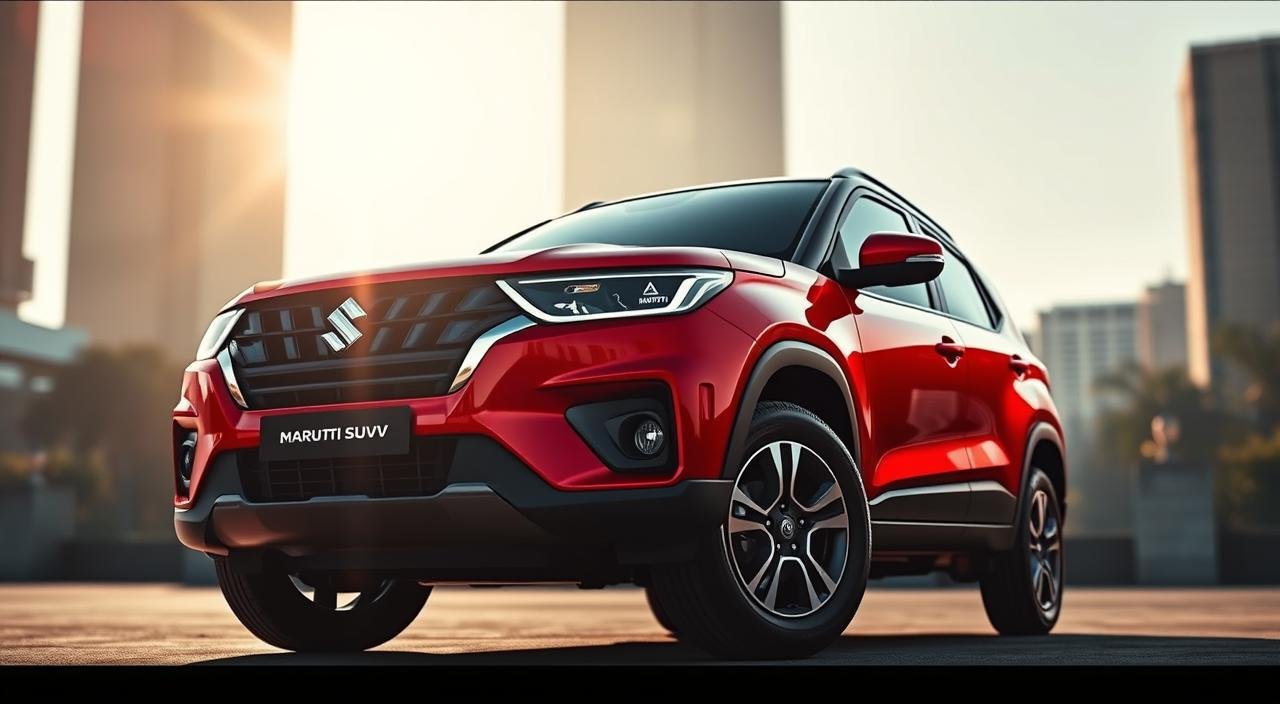
Jun
Is the legendary Escudo name coming back to India’s SUV market? Maruti Suzuki is set to introduce a new compact SUV. This has fans eagerly waiting.
The company is working on a vehicle called Y17. It will sit between the Brezza and Grand Vitara. Sources say it will be called Escudo, a name Maruti Suzuki trademarked in India last year.
The Escudo name has a rich history worldwide. Suzuki used it for the Vitara in Japan. This suggests the new SUV will be of high quality.
This SUV will be built on Suzuki’s Global C platform. It promises more room thanks to a longer wheelbase. Unlike the Grand Vitara, it will be sold at Arena dealerships. This means it will likely be more affordable for Indian buyers.
Key Takeaways
- Maruti Suzuki is developing a new compact SUV with the internal code Y17
- The vehicle will be positioned between the Brezza and Grand Vitara models
- Strong rumors suggest it will carry the Escudo nameplate, already trademarked in India
- The SUV will be built on Suzuki’s Global C platform with extended wheelbase
- Arena dealerships will sell the model, targeting a more affordable price segment
- The Escudo name has international heritage as the Vitara’s badge in Japan
Introduction to Maruti’s New SUV
Maruti Suzuki is getting ready to launch a new SUV that’s making everyone excited. They’re aiming to fill the gap between their Brezza and Grand Vitara. This move is to compete with Hyundai Creta, Kia Seltos, and Volkswagen Taigun in the compact SUV market.
Overview of Maruti Suzuki’s Market Strategy
Maruti knows what Indian car buyers want. They want premium features without spending too much. This new SUV is designed to grab a bigger piece of the growing SUV market in India.

The brand is all about affordable technology and saving fuel. They offer CNG options in many of their cars. This shows they care about the environment and are different from others.
Anticipated Features and Specifications
The new SUV will have amazing features that match more expensive cars:
- Redesigned dashboard with premium materials
- Large touchscreen infotainment system with wireless connectivity
- Fully digital instrument cluster
- Panoramic sunroof for an airy cabin feel
- Ventilated seats for comfort in Indian weather
- 1.5-liter K15C petrol engine with mild-hybrid technology
- Choice of 5-speed manual or 6-speed automatic transmission
These features make the new SUV a big deal in the compact SUV world. It offers top-notch features at a good price.
History of the Escudo Nameplate
The Escudo nameplate has a deep history in Suzuki’s global lineup. It was inspired by Portugal’s old currency. This name brings a sense of adventure and international flair.
In Japan and other places, Suzuki called their compact SUV the Escudo. But in the West, it was known as the Vitara. This shows how Suzuki adapts to different markets with its branding.
Previous Models and Their Impact
The first Escudo came out in 1988. It was a reliable and off-road-ready SUV. Over the years, it changed from a tough utility vehicle to a modern crossover.
The second generation, from 1997 to 2005, added more comfort without losing its adventurous feel. The third generation focused on being more city-friendly. It appealed to people who wanted a car for both city life and weekend adventures.

Evolution of the SUV Segment in India
India’s SUV market has grown a lot in the last ten years. Maruti Suzuki was quick to notice this change. They launched hits like the Brezza and Grand Vitara.
Maruti has a two-product strategy for SUVs. They aim to attract both compact and mid-size SUV buyers. If they bring back the Escudo, it could help them stand out in the SUV market.
| Model | Launch Year | Segment | Sales Success |
|---|---|---|---|
| Vitara Brezza | 2016 | Compact SUV | Over 700,000 units |
| Grand Vitara | 2022 | Mid-size SUV | 120,000+ bookings |
| Fronx | 2023 | Crossover | 100,000+ units |
Expectations for the New Maruti SUV
The car world is excited about Maruti’s new affordable SUV. It’s a mix of style and practicality. This model is part of the Toyota-Maruti partnership, aiming at those who want SUV looks but don’t want to spend a lot.

Design and Aesthetic Innovations
The new Maruti has a bold look. Its design has a squared-off stance, giving it a real SUV feel. It’s different from the sleek Grand Vitara, with a more upright face and clean lines.
Inside, Maruti aimed for a premium feel without the high cost. The cabin features:
- Soft-touch materials on key touchpoints
- Dual-tone upholstery for visual appeal
- A large 10.25-inch touchscreen infotainment system
- Improved dashboard layout with better ergonomics
Expected Engine and Performance Specifications
The power comes from a 1.5-liter K15C naturally aspirated petrol engine. It has mild-hybrid technology. This engine balances performance and fuel efficiency well, fitting India’s market.
Customers can pick between a 5-speed manual or a 6-speed torque converter automatic. The partnership chose to skip the strong-hybrid powertrain of the Grand Vitara. This keeps prices lower for more people.
What Sets the Escudo Apart?
The New Maruti SUV Coming Soon — Will It Be Called the Escudo? This question is important as Maruti Suzuki gets ready to launch a new car. It will sit between the Brezza and the Grand Vitara. This new model aims to offer great value by mixing affordability with top-notch features.
Distinctive Features of the Escudo
The Escudo is built on the Global C platform with a longer wheelbase. It shows Maruti’s dedication to safety and innovation. It comes with:
- Six airbags across all variants
- ABS with EBD for better braking
- Electronic Stability Control (ESC)
- Hill hold assist for safe driving
- All-wheel disc brakes for better stopping
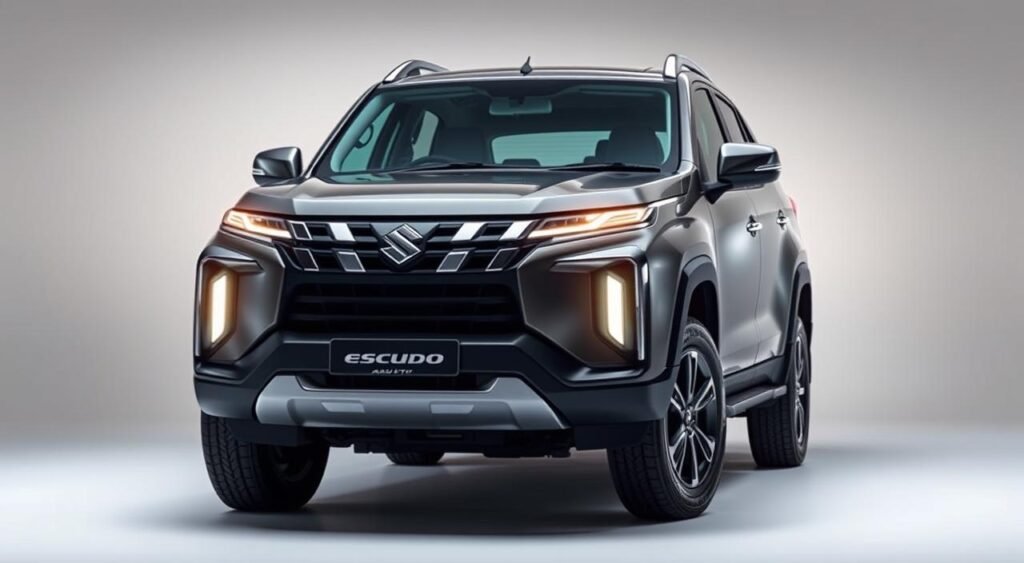
The car aims for a 5-star Bharat NCAP rating. This shows Maruti’s focus on keeping passengers safe. The higher trims might have a 360-degree camera and basic ADAS tech.
Comparison with Competitors in the Indian Market
The SUV market in India is very competitive. But the Escudo stands out. It’s priced between the Brezza and Grand Vitara, making it a great choice for those wanting premium features but not the high price.
Speculations Around the Name ‘Escudo’
The car world is buzzing with excitement about Maruti Suzuki’s new compact SUV. Last year, they trademarked two names in India: Escudo and Torqnado. This has led to lots of guesses about which name will be used.

Fan Theories and Insights from Experts
Car forums and social media are full of debates about the Escudo name. Fans remember the original Grand Vitara, sold as Escudo in some places. The name has a rich history from Suzuki’s global lineup, tied to the Vitara in Japan.
Experts think the Escudo badge could give Maruti Suzuki a unique spot in the SUV market. The name’s Portuguese origin adds a unique touch that might attract Indian buyers. This could make the car stand out in a crowded market.
Maruti Suzuki’s Branding Strategy
Using the Escudo name fits well with Maruti Suzuki’s SUV branding strategy. They’ve used well-known international names before, creating instant recognition. This approach helps the brand connect with global heritage while staying local.
The compact SUV market needs something new, and Escudo could be the key for Maruti Suzuki. The company is ready to update its SUV lineup quickly, matching changing tastes with bold names.
Release Date and Availability
The Indian auto market is excited as Maruti Suzuki gets ready to launch a new SUV. Experts say it will hit the market in September 2025, just before Diwali. This is the perfect time for car sales to rise in India.
Timeline for Launch in India
Maruti Suzuki is rushing to launch this SUV to catch the festive season demand. The September 2025 launch is ideal for Diwali shoppers. It also fits with Maruti’s plans to grow, including electric vehicles at their new Gujarat facility.
The SUV will be sold through Maruti’s Arena retail network, not Nexa showrooms. This makes it easier for more people to buy it in cities and towns.
Pre-booking Information and Expected Pricing
The SUV’s price is expected to be around Rs 9.7 lakh, making it a good deal. It will be priced between the Brezza and Grand Vitara models. This could draw in customers who want quality without spending too much.
- Expected price: Rs 9.7 lakh (ex-showroom)
- Distribution: Arena dealership network
- Pre-booking: Details expected by July 2025
- Launch window: September 2025
The strategic pricing is about one lakh rupees less than the Grand Vitara. It’s also close to the top Brezza variants. This could attract buyers who want good features at a fair price.
Customer Reactions and Market Predictions
The automotive world in India is buzzing with excitement about Maruti’s new compact SUV. Social media is full of talks and guesses about this affordable car. It’s expected to change the game in the competitive segment.
Social Media Buzz and Consumer Interest
Twitter and Instagram are filled with thousands of posts about the upcoming launch. Car lovers are thrilled about the features this SUV will have at a good price. The main topics include:
- Panoramic sunroof availability in an affordable SUV
- Ventilated seats for Indian weather conditions
- Suzuki Connect technology for smartphone integration
- CNG variant options for fuel efficiency
YouTube channels focused on cars have millions of views on videos about this model. The excitement is high among first-time buyers. They want a car that’s packed with features but won’t cost too much.
Forecasted Sales and Market Reception
Experts think this SUV will sell well in its first year. It’s placed perfectly between other successful models. They believe it will take a big share of the market, currently held by Hyundai Creta and Kia Seltos.
The Arena dealership network’s wide reach in India makes the SUV more accessible. This, along with Maruti’s reliable service network, will help it gain popularity in smaller cities.
Conclusion: What Lies Ahead for Maruti SUV Enthuisiasts
Maruti Suzuki is at a key moment in its SUV journey. The company is pushing hard into the compact SUV market. It wants to grab every segment it can.
The Y17-codenamed vehicle is joining Maruti’s lineup. It aims to fill a gap between current models. This move is based on years of knowing what Indian customers want.
Final Thoughts on the Escudo Potencial
The Escudo name might return, bringing both nostalgia and excitement. This compact SUV will have features that match top segment leaders. It will also keep Maruti’s value reputation.
The wide service network across India is a big plus. This SUV, whether Escudo or not, shows Maruti’s aim to grow its range.
Future of Maruti Suzuki in the SUV Segment
Maruti’s SUV plans go beyond one model. The electric e Vitara and other launches show the brand’s new market leadership. The Toyota-Maruti partnership adds advanced tech and shared skills to new cars.
As India’s SUV market grows fast, Maruti Suzuki is ready to lead. It will do this with competitive prices, reliable cars, and wide availability.
The new compact SUV is a big step for Maruti. It’s moving from being a small-car expert to a full automotive brand. With many SUVs coming and the Toyota-Maruti partnership, fans can look forward to more exciting cars. The SUV market in India will get more competitive, but Maruti’s deep understanding of the market will keep it ahead.
FAQ
What is the expected launch date for the new Maruti SUV?
The new Maruti SUV, called Y17, is set to launch before Diwali 2025. It might debut around September. This timing aims to catch the buying surge during the festival season.
Will the new SUV be called Escudo?
Maruti Suzuki trademarked Escudo and Torqnado in India last year. Escudo has a strong history, used for the Suzuki Vitara in Japan. It’s a top choice for this new compact SUV.
What will be the price range of the new Maruti SUV?
The SUV’s starting price is expected to be around Rs 9.7 lakh (ex-showroom). It will be priced to compete with the Brezza’s mid-variant. It will also undercut the base Grand Vitara by about one lakh rupees.
Which dealership network will sell this SUV?
The SUV will be sold through Maruti’s Arena dealerships. This ensures wider accessibility and keeps its affordable price. The Grand Vitara, sold through Nexa, is more premium.
What engine options will be available?
The SUV will have a 1.5-liter K15C naturally aspirated petrol engine. It will come with mild-hybrid technology and a choice of 5-speed manual or 6-speed automatic transmission. A CNG variant is also expected.
How will it compete with rivals like Hyundai Creta and Kia Seltos?
The new Maruti SUV will compete in the compact SUV segment. It will face rivals like Hyundai Creta, Kia Seltos, and others. It aims to win market share with competitive pricing and features.
What are the key features expected in this SUV?
The SUV will have a 10.25-inch touchscreen infotainment system. It will also have a fully digital instrument cluster, panoramic sunroof, and ventilated seats. It will have 360-degree camera and six airbags as standard.
What platform will the new SUV be based on?
The SUV will be built on Suzuki’s Global C platform. It will have a longer wheelbase for more cabin space. This platform ensures better interior and safety.
How does this fit into Maruti’s overall SUV strategy?
The new SUV fills a gap between the Brezza and Grand Vitara in Maruti’s lineup. It shows Maruti’s commitment to SUVs. It’s part of a strategy that includes the upcoming electric e Vitara.
Will the Escudo achieve good safety ratings?
The vehicle is expected to get a 5-star Bharat NCAP rating. It will have standard safety features like six airbags and ABS with EBD. It will meet safety expectations in the Indian market.
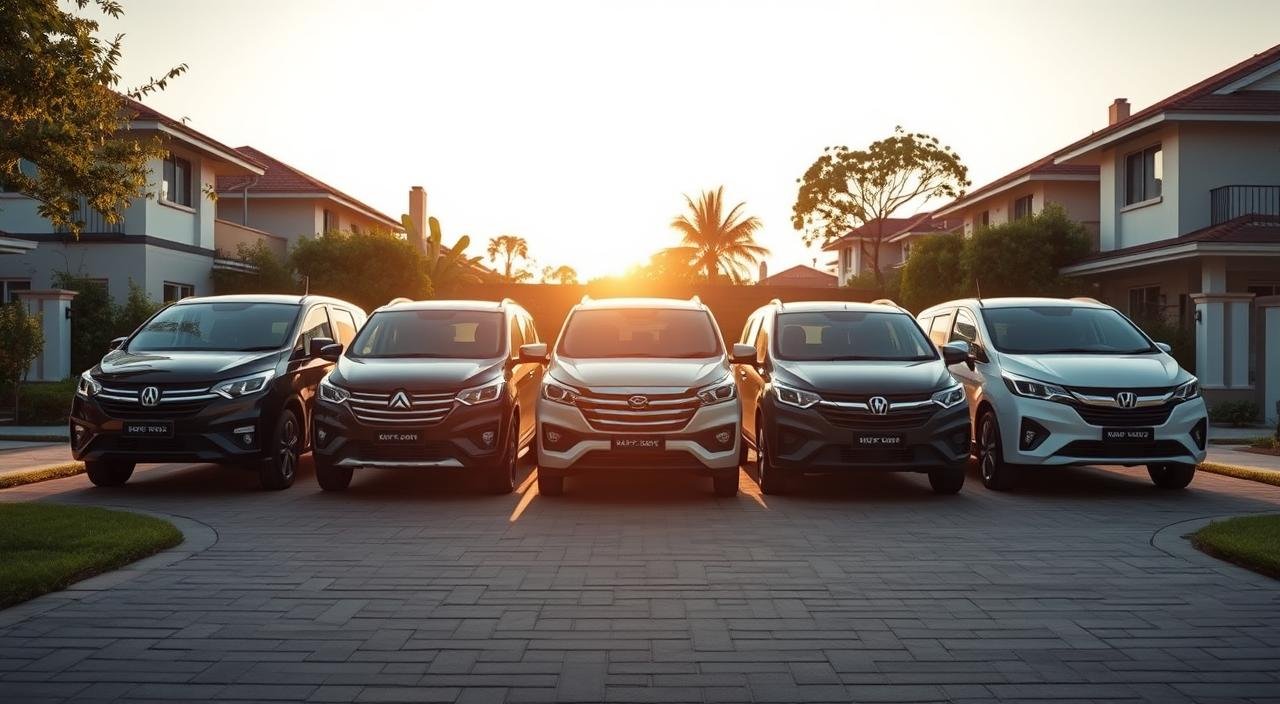
Jun
Finding the right car for your family can be tough. You want space, comfort, and good value. Luckily, India has many affordable MPVs that make family trips better without costing too much.
There are 18 different 7-seater models under ₹20 lakh. Prices start at ₹8.97 lakh for the Maruti Suzuki Ertiga and go up to ₹19.99 lakh for the Toyota Innova Crysta. These cars meet various needs and budgets.
Models like Kia Carens Clavis and Toyota Innova Hycross are very popular. They offer lots of space and useful features. Some models have long waiting times, up to 122 weeks. But, others can be driven home in just 4 weeks.
Key Takeaways
- India offers 18 different 7-seater vehicles under ₹20 lakh, providing extensive choices for families
- Price range spans from ₹8.97 lakh for Maruti Suzuki Ertiga to ₹19.99 lakh for Toyota Innova Crysta
- Kia Carens Clavis and Toyota Innova Hycross rank among the most popular choices
- Waiting periods vary dramatically from 0-4 weeks to 0-122 weeks depending on the model
- Top contenders include established brands like Toyota, Mahindra, Kia, and Maruti Suzuki
- Each model offers unique combinations of space, features, and value propositions
Introduction to MPVs and Their Importance for Families
Multi-Purpose Vehicles (MPVs) are key for Indian families looking for practical cars. They offer roomy interiors, safety, and tech for all family needs. Perfect for school runs and weekend trips, MPVs mix comfort, efficiency, and value under ₹20 lakh.
What is an MPV?
An MPV is a car made for carrying many people in three rows of seats. They are bigger than sedans, focusing on space and comfort. In India, you can find models like the Maruti Suzuki Ertiga, Toyota Innova Crysta, and Kia Carens.
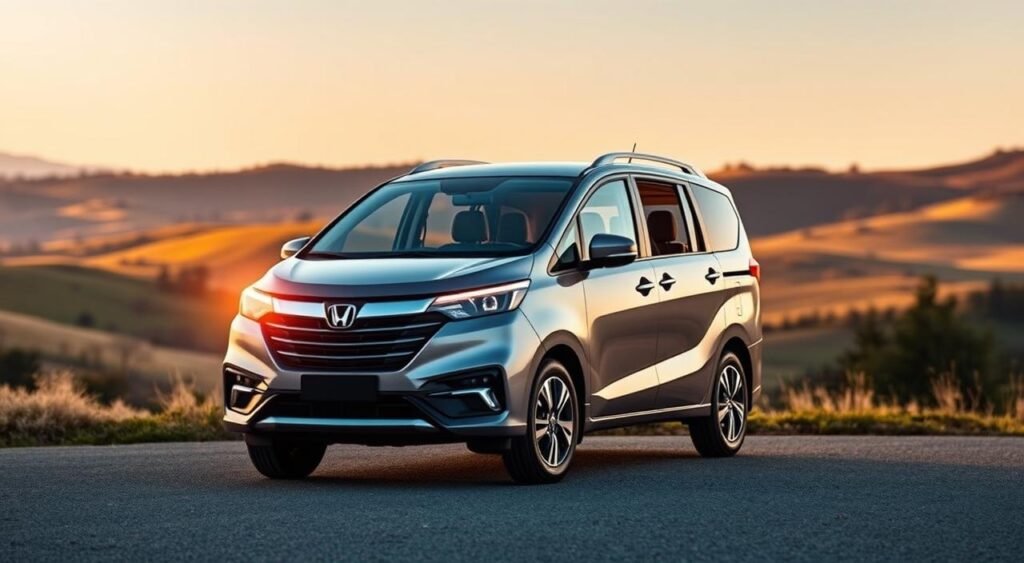
Benefits of MPVs for Family Travel
MPVs are great for long trips because they offer maximum comfort. Their big interiors help avoid tiredness on long drives. They also have flexible seats and fun infotainment systems. Plus, they save money by being more cost-effective than buying several smaller cars.
Key Features to Look for in an MPV
When choosing a family MPV, look for these important features:
- Three-row seating with easy third-row access
- Comprehensive safety features including multiple airbags and ABS
- Fuel-efficient engines for good mileage
- Modern infotainment systems with smartphone connectivity
- Adequate boot space even with all seats occupied
| Feature Category | Essential Elements | Why It Matters |
|---|---|---|
| Seating | 7-8 seats, adjustable configurations | Accommodates large families comfortably |
| Engine | 1.5L-2.4L displacement | Balances power with fuel efficiency |
| Safety | Dual airbags, ABS, parking sensors | Protects all passengers |
Review of the Top 5 MPVs Under ₹20 Lakh
Choosing the right MPV for your family is important. There are four top models under ₹20 lakh in India. Each offers great comfort, space, and value for family transport.
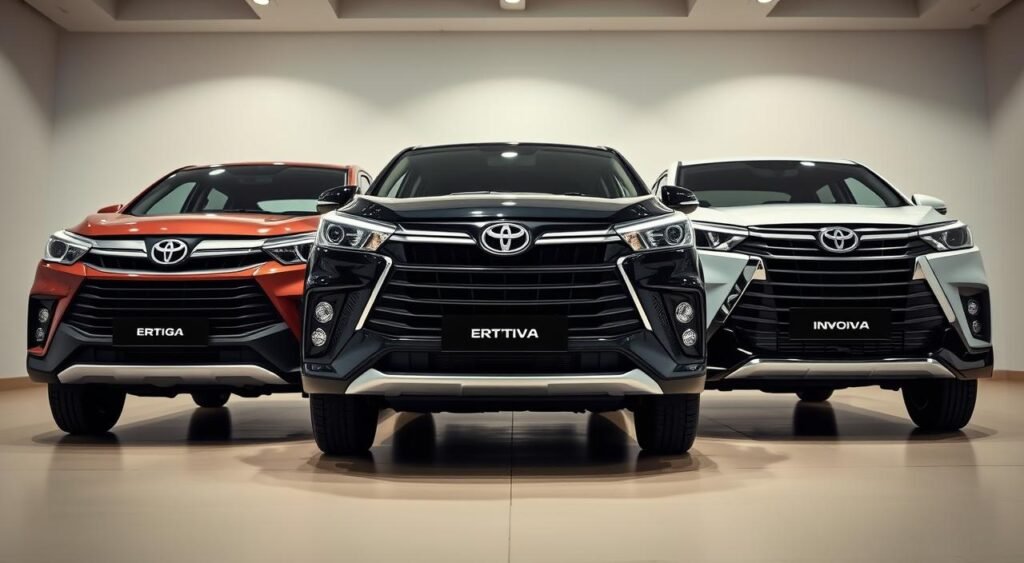
1. Maruti Suzuki Ertiga
The Maruti Ertiga is India’s most affordable 7-seater MPV. It costs between ₹8.97-13.26 lakh. It has many variants, from LXi to ZXi Plus AT, with manual and automatic options.
It also has good fuel economy. You get 20.51 kmpl on petrol and 26.11 kmpl on CNG.
2. Toyota Innova Crysta
The Toyota Innova Crysta is at the premium end, priced from ₹19.99-26.82 lakh. It’s a diesel MPV with various trims, from GX to ZX. You can choose between 7 and 8-seater options.
3. Mahindra Marazzo
The Mahindra Marazzo is priced between ₹14.59-17.00 lakh. It has three main variants: M2, M4 Plus, and M6 Plus. It offers both 7 and 8-seater options for different family sizes.
4. Kia Carens
The Kia Carens comes in two model lines. The standard version costs ₹10.60-19.70 lakh. The Carens Clavis ranges from ₹11.50-21.50 lakh.
It has many variant choices with petrol and diesel engines. You can choose from manual, automatic, iMT, and DCT transmissions. Fuel efficiency varies from 15.95-19.54 kmpl.
In-Depth Analysis of Each MPV
Each MPV in this category has its own strengths for family transport. They offer fuel-efficient engines and spacious interiors. These features make them practical and affordable.
Performance and Engine Specifications
The Renault Triber has a 1.0-liter three-cylinder petrol engine. It’s compact but powerful for city driving and saves fuel. You can choose from manual or AMT transmissions, and there’s a CNG version for better costs.
Maruti Suzuki Ertiga and Toyota Rumion have similar engines with CNG options. Kia Carens offers various engines, including petrol, diesel, and turbo. You can pick from manual, iMT, or automatic transmissions to match your driving style.
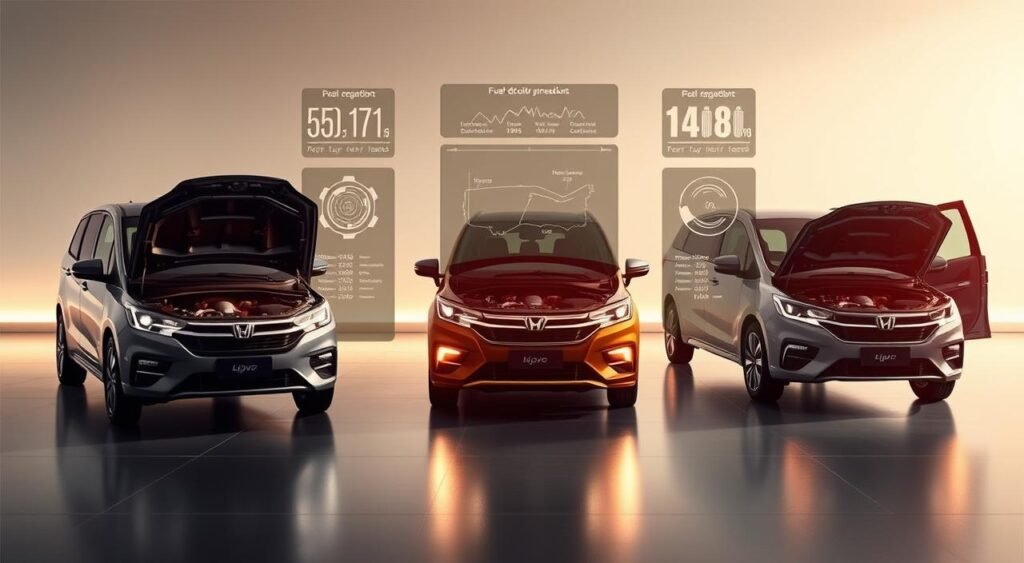
Interior Space and Comfort
The Renault Triber has removable third-row seats for more cargo space. It also has a digital instrument cluster and touchscreen infotainment. The Ertiga offers traditional three-row seating and connected car tech.
Kia Carens focuses on comfort with premium materials and roof-mounted AC vents. It has a large touchscreen and digital driver display. All models aim to provide ample space for families on long trips.
Safety Features and Ratings
| Model | Safety Rating | Key Safety Features |
|---|---|---|
| Renault Triber | 4-star GNCAP | Dual airbags, ABS, rear parking sensors |
| Maruti Ertiga | 3-star GNCAP | Dual airbags, ESP, hill hold assist |
| Kia Carens | 3-star GNCAP | Six airbags, ESC, TPMS |
Safety is a top priority for these MPVs. The Renault Triber gets a four-star GNCAP rating, leading the segment. Kia Carens has multiple airbags and electronic stability systems. The upcoming Carens Clavis will add ADAS features for better protection.
Comparisons Between the Top Choices
Choosing the right MPV for your family is important. Comparing different models helps you make a good choice. Each affordable MPV has its own benefits, from price to features and how well they perform in real life. Let’s see how these family-friendly vehicles compare.
Price Comparison
The prices of these MPVs vary to fit different budgets. The Renault Triber is the most affordable, starting at ₹6.14 lakh. The Maruti Ertiga and Toyota Rumion offer great value in the mid-range. The Kia Carens is in the premium range, while the Toyota Innova Crysta is the most expensive at ₹19.99 lakh.
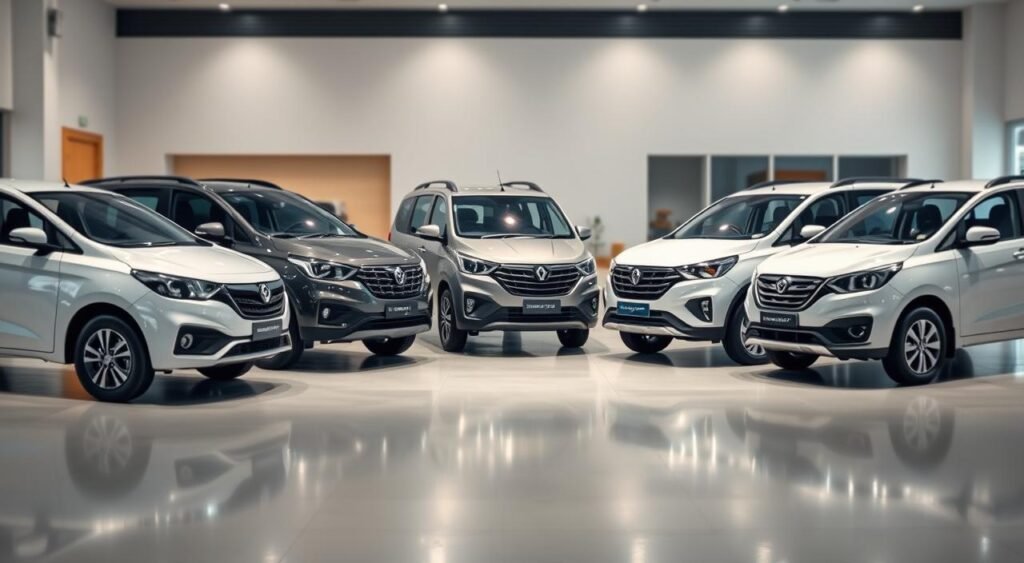
Feature and Specifications Comparison
Each model has its own special features. The Renault Triber has a removable third row, great for families needing extra space. The Maruti Ertiga and Toyota Rumion are very fuel-efficient, even with CNG variants. The Kia Carens has many engine options and a luxurious interior. The Kia Carens Clavis adds ADAS technology and new styling.
Customer Feedback and Reviews
Real-world experiences offer valuable insights. Toyota Innova Hycross owners say it’s fuel-efficient and looks great on the road. The Mahindra Scorpio N is praised for its driving position and strong engines. The Mahindra XUV700 is seen as a great value with lots of features. Some Kia Carens Clavis owners mention slow acceleration in low gears. The Toyota Innova Crysta is loved for its strong engine and great torque.
Considerations When Choosing an MPV
Choosing the right MPV for your family is more than just looking at safety and entertainment. It’s about considering long-term satisfaction and budget. Knowing these factors helps families make choices that fit their needs and budget.
Budget and Cost of Ownership
MPV prices in India vary a lot. The Renault Triber starts at ₹6.14 lakh, while the Toyota Innova Crysta costs up to ₹19.99 lakh. Prices also change based on where you live due to taxes and fees.
Monthly costs for upkeep range from ₹1,000 to ₹3,000. This depends on the model and how much you drive. Models with more features might cost more to maintain.
Maintenance and Service Availability
Having access to service centers is key. Maruti Suzuki has many centers across India, making maintenance easy. But, premium brands might have fewer locations, affecting service times and parts availability.
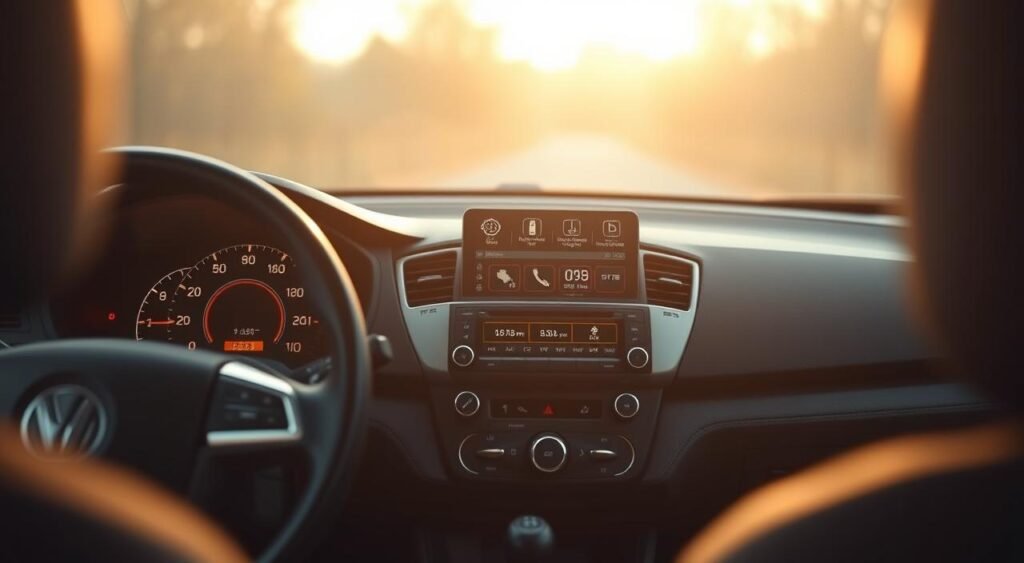
Fuel Efficiency and Environmental Impact
Fuel efficiency varies among MPVs. City driving gets 9-12 kmpl, while highways get 16-26 kmpl. CNG models like the Ertiga and Triber save money. The Toyota Innova Hycross hybrid gets 23.24 kmpl, combining efficiency with performance.
For those who care about the environment, electric options are available. The MG Windsor EV is a zero-emission choice. The Kia Carens Clavis EV is coming soon, adding more electric MPV options. These models cut down on emissions while keeping up with modern tech and safety.
Conclusion: Choosing the Best MPV for Your Family
Choosing the right MPV depends on what you need and want. Each car has its own benefits for different families. The Renault Triber is the cheapest at ₹6.14 lakh, great for growing families with its flexible seats.
The Maruti Ertiga and Toyota Rumion are reliable and have CNG options for ₹9-10 lakh. They’re perfect for daily use because they save fuel.
Summary of Top Picks
The Kia Carens offers modern features and style for ₹10.52-19.70 lakh. It’s great for families who love technology. The Mahindra Marazzo is built to last at ₹14.59-17.00 lakh, ideal for those who value durability.
The Toyota Innova Crysta is the top choice at ₹19.99 lakh. It offers unmatched comfort and looks. Each of these cars meets different needs with its own strengths.
Final Recommendations for Family Travel
For those on a budget, the Renault Triber is a good choice. It’s affordable and has a versatile interior. The Maruti Ertiga with CNG is best for saving money on fuel.
The Kia Carens is perfect for families who want the latest tech and style. The Toyota Innova Crysta is the best for luxury and space, even if it costs more.
Encouragement to Test Drive Before Buying
Test driving is key when choosing a family car. It lets you see how comfortable the third row is and how the car handles. You can also check how well the features work in real life.
Testing the fuel efficiency is important too. Visit different dealerships to see what services they offer and compare prices. This helps you make a well-informed decision.
FAQ
What are the most affordable MPVs under ₹20 lakh for families?
The Renault Triber starts at ₹6.14 lakh. The Maruti Suzuki Ertiga begins at ₹8.97 lakh. The Mahindra Bolero is priced at ₹9.81 lakh. The Toyota Rumion costs ₹10.54 lakh, and the Kia Carens starts at ₹11.41 lakh. These vehicles are great for families, with lots of room and useful features.
Which MPV offers the best fuel efficiency under ₹20 lakh?
The Maruti Suzuki Ertiga’s CNG version gets 26.11 km/kg. Its petrol version gets 20.51 kmpl. The Toyota Innova Hycross hybrid gets 23.24 kmpl. These high fuel efficiencies help save money on gas for family trips.
What safety features should I expect in MPVs under ₹20 lakh?
These MPVs have many safety features. They include airbags, ABS with EBD, electronic stability control, and ISOFIX child seat anchors. The Renault Triber got a four-star GNCAP safety rating. The Kia Carens Clavis has advanced ADAS features like lane keeping assist and automatic emergency braking.
Which MPV has the most advanced infotainment system?
The Kia Carens and Kia Carens Clavis have the latest infotainment systems. They have big touchscreen displays, connected car tech, wireless smartphone connectivity, and premium audio. The Maruti Suzuki Ertiga and Toyota Rumion also have SmartPlay Pro and Smart Playcast systems with Android Auto and Apple CarPlay.
What is the waiting period for popular MPVs under ₹20 lakh?
The Toyota Innova Hycross has a long waiting period of 0-122 weeks. The Renault Triber has a short wait of 0-4 weeks. The Maruti Suzuki Ertiga, Kia Carens, and Mahindra Marazzo have waits of 4-8 weeks, depending on the model and location.
Are there any electric or hybrid MPV options under ₹20 lakh?
The Toyota Innova Hycross has a hybrid version at ₹19.94 lakh. It’s very fuel-efficient. For electric options, look at the Kia Carens Clavis EV or the MG Windsor EV. They’re good for zero-emission family travel, but details are not yet confirmed.
Which MPV offers the best third-row comfort for adults?
The Toyota Innova Crysta has the best third-row comfort. It has lots of legroom, headroom, and AC vents. The Mahindra Marazzo also has good third-row space. The Kia Carens has decent third-row access but is better for kids or short trips.
What are the maintenance costs for MPVs under ₹20 lakh?
Maintenance costs for these MPVs are ₹1,000-3,000 per month. The Maruti Suzuki Ertiga has the lowest costs due to its wide service network and affordable parts. The Toyota Innova Crysta may cost more but offers better reliability and resale value.
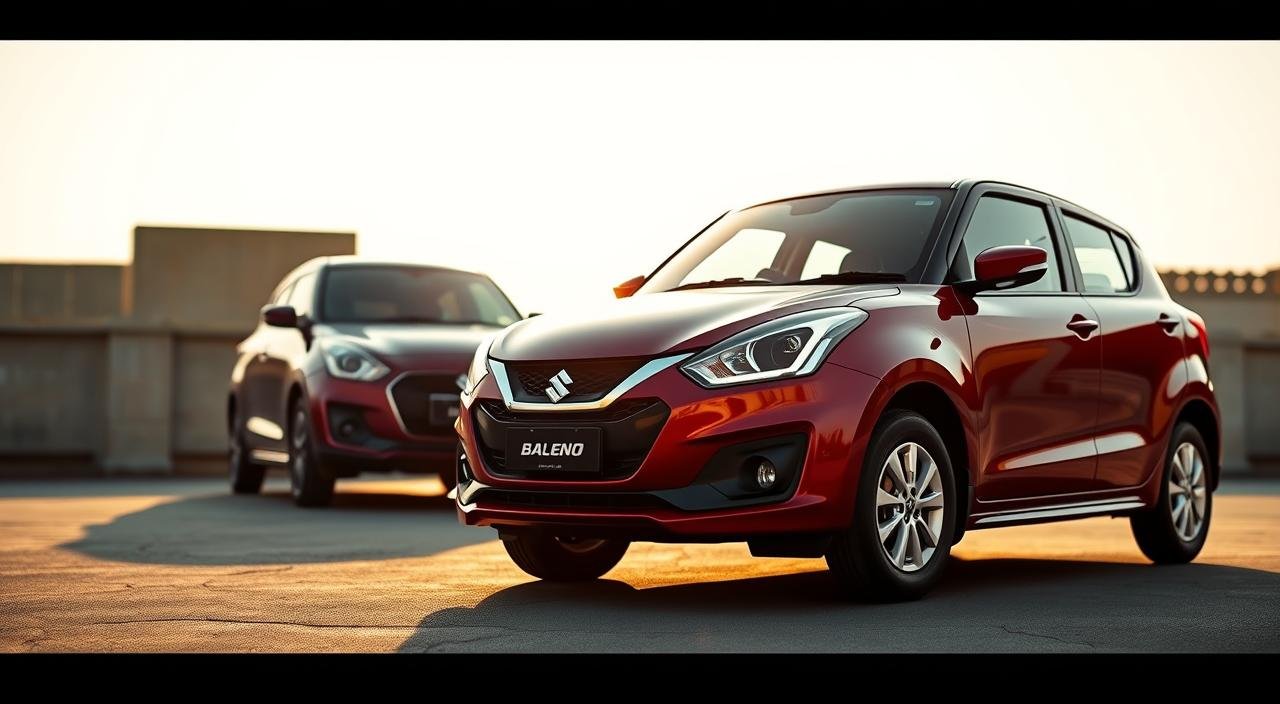
Jun
Which compact car offers the best value for Indian families looking for style and efficiency? The Maruti Suzuki Baleno and Suzuki Swift have been favorites on Indian roads for years. But recent updates have changed the game. The Baleno now stands out as the top choice in this popular category.
The Suzuki Swift was once loved for its lively diesel engine and agile handling. But today’s Swift is different. It now has a 1.2-liter three-cylinder engine that makes 82 PS and 112 Nm of torque. This change from performance to fuel economy is a big shift from its past.
The Maruti Suzuki Baleno fills the gap left by the Swift. It costs only a bit more but offers more room, premium features, and better value. When you compare both cars, it’s clear why the Baleno is the better choice.
Key Takeaways
- The Suzuki Swift has moved away from its sporty roots to focus on fuel efficiency
- New Swift features a smaller 1.2-liter engine with reduced power output
- The Maruti Suzuki Baleno offers more space for a minimal price increase
- Premium features come standard in the Baleno at competitive price points
- Swift’s identity crisis opens opportunities for Baleno to capture market share
- Value-conscious buyers find better propositions in the Baleno’s package
Introduction: The Iconic Rivalry Between Baleno and Swift
The Maruti Suzuki Swift and Baleno are two top compact hatchbacks in India. They are rivals within the same brand family. Each car has its own appeal, attracting different buyers with varying budgets.
The Swift is known for its fun drive and sporty look. It’s a favorite among young drivers. But, when prices hit Rs 10 lakh, its value starts to fade.
The Baleno, on the other hand, offers more luxury and space. It’s a step up in quality and price. For those willing to spend a bit more, the Baleno is a better deal.
This price gap between the Swift and Baleno is interesting. The Swift is priced between the Wagon R and the Baleno. Yet, its prices often get close to the Baleno’s. This makes it hard to see what each model offers for the money, when prices go over Rs 10 lakh.
Knowing these differences helps buyers choose wisely. They can decide based on what matters most: driving dynamics or overall refinement.
Design and Aesthetics: A Closer Look at Both Models
The Maruti Baleno and Swift have different designs that attract various buyers. The Baleno is all about elegance and usefulness. On the other hand, the Swift is sporty and youthful.
Exterior Design: First Impressions Matter
The Baleno stands out with its bigger size and sleek look. It’s longer and wider than the Swift, giving it a strong presence on the road. This makes it look more mature and stylish.
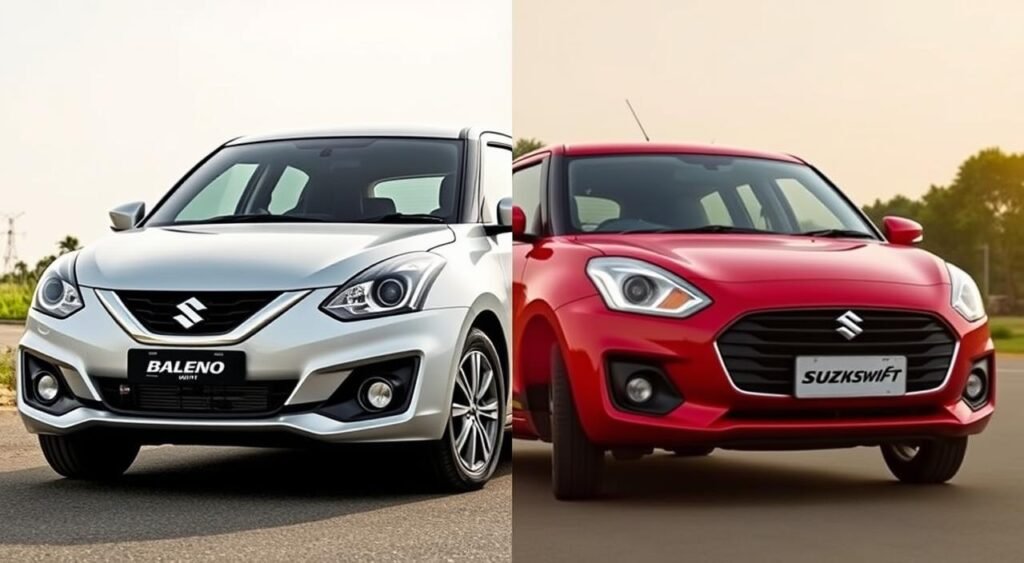
The Swift, with its sharp lines and bold front, looks sporty and quick. Its small size makes it perfect for city driving, where quick turns are key.
Interior Comfort: Space and Ergonomics
The Baleno has more room inside, with more space for legs and knees. It also has a bigger boot, with 318 liters, compared to the Swift’s 265 liters. This means you can carry more stuff.
The Swift’s interior is modern and sporty, with a focus on the driver. The Baleno, on the other hand, is all about comfort and practicality. It’s great for long trips and family use.
Color Options: Standing Out in the Crowd
Both cars offer a wide range of colors to suit everyone’s taste. The Baleno has elegant colors that match its high-end feel. The Swift, with its bright colors, lets you show off your personality.
Performance: Engine and Driving Experience
When we look at the Maruti Baleno and Swift, we see clear differences in their engines. The Baleno has a four-cylinder engine for a smoother ride. The Swift, with its three-cylinder engine, is more compact and efficient. These choices affect fuel efficiency and how the cars handle on Indian roads.
Engine Specifications: Power vs. Efficiency
The Maruti Baleno has a K-Series 1.2-liter four-cylinder engine that makes 90 PS. It’s known for being one of the best in its class. The Swift, on the other hand, has a 1.2-liter three-cylinder engine that makes 82 PS, 8 PS less than the Baleno.
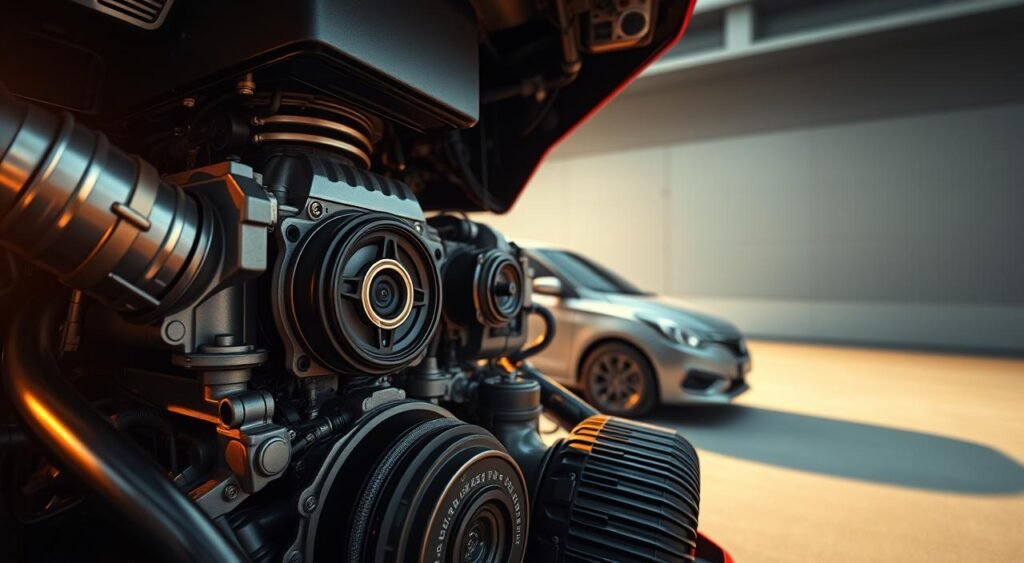
| Specification | Maruti Baleno | Maruti Swift |
|---|---|---|
| Engine Type | 1.2L Four-Cylinder | 1.2L Three-Cylinder |
| Power Output | 90 PS | 82 PS |
| Configuration | K-Series | New Generation |
Handling and Ride Comfort: On the Road
Both cars do well in city driving up to 80 kmph. The Baleno’s engine is smoother and has less vibration than the Swift’s. At speeds over 100 kmph, the Baleno handles better and feels more refined.
This makes it safer at high speeds. The extra 8 PS also helps with overtaking, making it safer and more convenient.
Features and Technology: What Each Car Offers
When we compare the Maruti Suzuki Baleno and Swift, tech and safety are key. Both cars have modern features, but they differ in what matters most for daily driving. This includes comfort and safety.
Infotainment Systems: Staying Connected
The Maruti Suzuki Baleno has a top-notch infotainment system. It includes a 360-degree camera for easy parking in tight spots. This is super useful in crowded Indian cities.
The Baleno also has a heads-up display. It shows important driving info on the windshield. This lets drivers keep their eyes on the road.
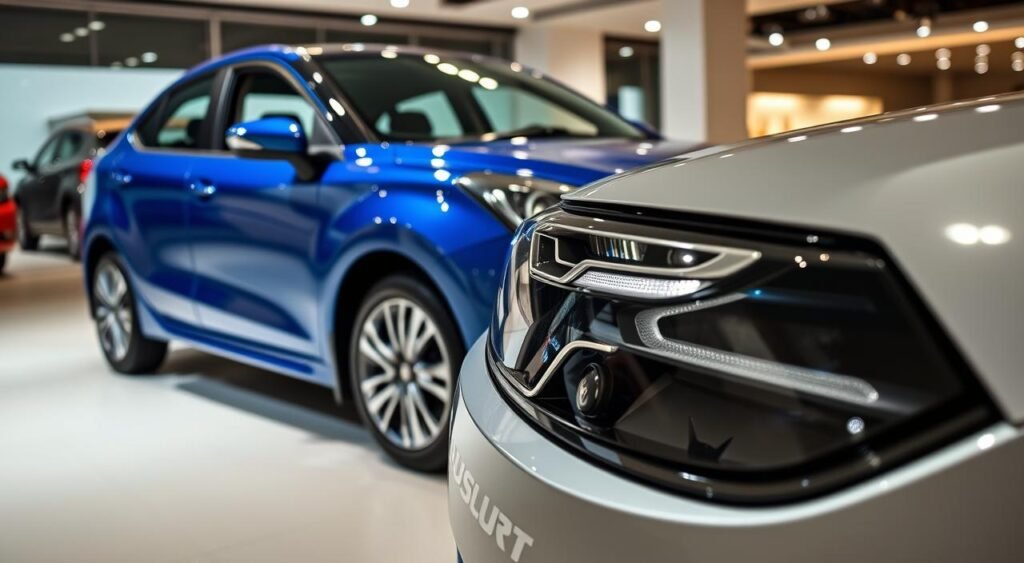
The Baleno’s cabin offers better comfort for passengers. It has a front center armrest, which the Swift lacks. This makes long trips more comfortable for everyone.
Safety Features: Protection on Every Drive
Maruti Suzuki focuses on keeping passengers safe. They plan to add six airbags to all cars within a year. Already, ten models, like the Alto K10 and WagonR, have them as standard.
Both the Baleno and Swift have Electronic Stability Program (ESP) in all versions. This is a big safety feature.
| Safety Feature | Baleno | Swift |
|---|---|---|
| Bharat NCAP Rating | 4 Stars | Not Tested |
| 360-Degree Camera | Available | Not Available |
| ESP | Standard | Standard |
| Front Center Armrest | Yes | No |
The Dzire got a 5-star Bharat NCAP rating, while the Baleno scored 4 stars. These ratings show the Baleno’s strong crash protection. With its advanced features, the Baleno is a great pick for families. It offers value without sacrificing tech and safety.
Fuel Efficiency: Cost-Effectiveness Over Time
Fuel economy is key when picking compact hatchbacks in India. The Maruti Baleno and Suzuki Swift offer great mileage. They help save money without losing fun in driving.
Mileage Comparisons: Swift vs. Baleno
The Suzuki Swift leads in fuel efficiency with 25.75 kmpl. The Baleno follows with 22.94 kmpl. But, real-world driving shows a different story.
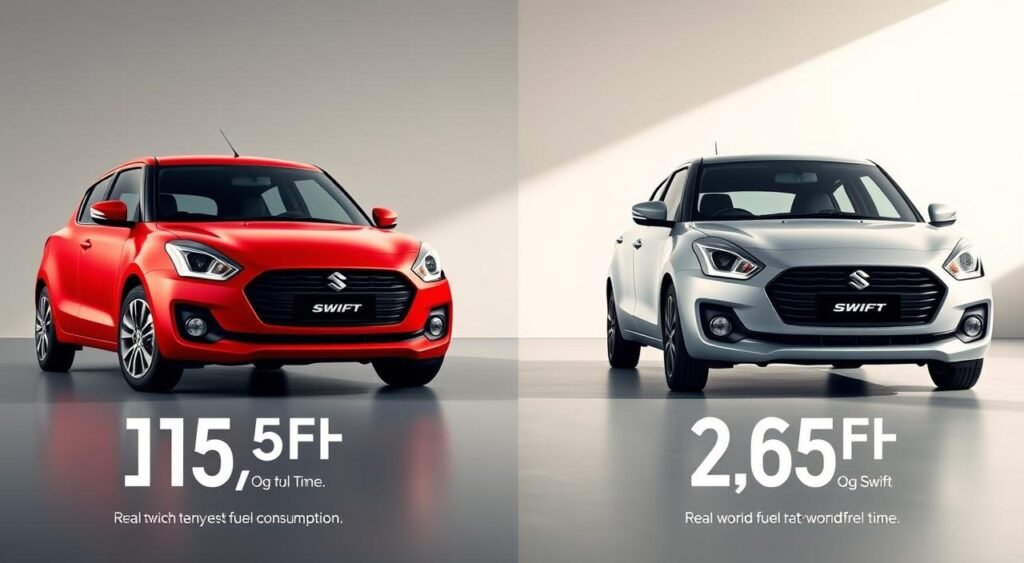
In city driving, both cars do well. The Swift’s light build helps in traffic. The Baleno’s engine gives a smoother ride, pleasing many drivers.
Fuel Tank Capacity: Longer Journeys Made Easy
Both cars have fuel tanks big enough for Indian roads. The Swift has a 37-liter tank, and the Baleno has a bit more. They both can go about 850-950 kilometers on one fill-up.
The tanks are close in size, making refueling almost the same for both. Long trips are easy with either car, needing few fuel stops.
Pricing and Value for Money: Which is the Better Deal?
When looking at the Maruti Swift and Baleno, price is key. Both cars aim to please budget-conscious buyers in India’s hatchback market. Knowing the prices and long-term value helps decide which car is the better buy.
Initial Costs: Buying Options
The Swift starts at Rs 6.49 lakh and tops out at Rs 9.65 lakh. The Baleno begins at Rs 6.7 lakh and reaches Rs 9.92 lakh. This Rs 25,000 difference shows the Baleno’s higher market status.
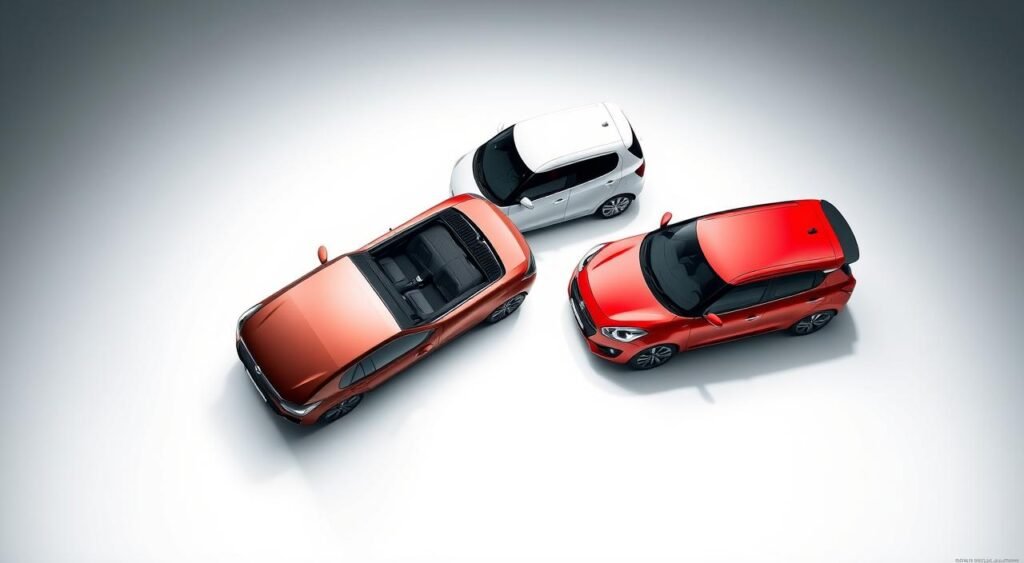
| Model | Base Variant (Rs) | Top Variant (Rs) | Price Range (Rs) |
|---|---|---|---|
| Maruti Swift | 6.49 lakh | 9.65 lakh | 3.16 lakh |
| Maruti Baleno | 6.70 lakh | 9.92 lakh | 3.22 lakh |
Resale Value: Long-Term Investment
The Swift has a 20-year history in India, building strong loyalty. Yet, car reviews often praise the Baleno for its better features and refinement. The Baleno’s extra cost means more space, tech, and fuel efficiency.
These benefits lead to higher resale values. The Baleno’s modern design and rich features make it a wise choice for long-term value.
Customer Reviews: Insights from Real Owners
Maruti Baleno and Swift owners share their real-world experiences. They talk about what they like and dislike. This helps others decide which car is best for them.
Positive Feedback: Why Drivers Prefer Baleno
Baleno owners love the K-Series engine. They say it’s smooth and reliable. The engine’s power is great for city driving and long trips.
They also love the car’s roomy interior. It’s perfect for family outings.
- Premium cabin materials and finish quality
- Generous rear seat legroom and headroom
- Smooth gear shifts and clutch operation
- Feature-rich infotainment system
- Excellent fuel economy in real-world conditions
Concerns Raised: Common Issues Noted
Swift owners have mixed feelings about the engine. They miss the old four-cylinder engine. Younger buyers want a sportier Swift.
Some Swift owners wish for a more powerful version. They dream of a Swift RS.
| Model | Common Praise | Frequent Concerns |
|---|---|---|
| Baleno | Spacious interior, smooth engine | Higher price point |
| Swift | Compact size, brand legacy | Reduced sportiness, cabin space |
Experts say Baleno’s engine is better for those who value smoothness. The extra space and features are worth the extra cost for many.
Conclusion: The Clear Winner in the Baleno vs Swift Debate
The Maruti Baleno stands out as the top choice for car buyers in India. It offers great value with its smooth engine, quiet cabin, and roomy interior. This makes it perfect for five adults.
Both cars use Maruti’s updated Heartect platform, boosting their safety. The Baleno got 70kg heavier, and the Swift 20kg, thanks to new chassis parts. These changes help them handle better and protect in crashes.
The Swift is loved for its sporty look and fuel-saving abilities. It’s been India’s top hatchback for 20 years, showing it’s reliable and trusted. But, the Swift’s price is a bit high compared to the Baleno’s full package.
Here’s why the Baleno is the better choice:
- Superior engine refinement with minimal vibrations
- Spacious rear seat and boot capacity
- Premium interior materials and finish
- Competitive pricing despite extra features
If you’re looking for a car that’s big on space, comfort, and value, the Baleno is it. The Swift is great for city driving, but the Baleno offers more for most families looking for a new hatchback.
Call to Action: Experience the Baleno Difference Today!
The Maruti Baleno is a top choice for many. It offers great value. Visit your nearest Maruti Suzuki dealership for a test drive. You’ll see why its engine and handling are unmatched.
At the showroom, check out the Baleno’s advanced features. The 360-degree camera system makes parking safer. The heads-up display keeps important info in your sight. These features are standard in higher models, adding value.
Smart buyers look at more than just the price. The Baleno holds its value well. It’s also cheap to maintain and fuel-efficient. Visit your local dealership to see how the Baleno beats the competition in real life.
FAQ
What are the key differences in fuel efficiency between the Maruti Baleno and Suzuki Swift?
The Swift claims better fuel efficiency at 25.75 kmpl compared to the Baleno’s 22.94 kmpl. This is a 2.81 kmpl difference. Yet, in real driving, the fuel use is almost the same. The Swift focuses on fuel efficiency, while the Baleno balances performance and efficiency.
How do the interior features and space compare between these two compact hatchbacks?
The Baleno has more interior space, better legroom, and knee room than the Swift. It also has a bigger boot at 318 litres compared to the Swift’s 265 litres. The Baleno comes with premium features like a 360-degree camera system and heads-up display. The Swift lacks a front centre armrest, affecting comfort.
What are the performance comparison differences between the engines?
The Baleno has a K-Series 1.2-litre four-cylinder engine making 90 PS. The Swift’s new 1.2-litre three-cylinder engine makes 82 PS, 8 PS less. The Baleno’s engine is smoother and more sophisticated. It performs better at high speeds than the Swift.
How do the safety ratings compare between the Baleno and Swift?
The Baleno got a 4-star safety rating under Bharat NCAP testing. Both cars have updated platforms and chassis reinforcements. The Baleno’s weight increased by 70kg, and the Swift’s by 20kg for safety. Maruti Suzuki will add six airbags to all passenger vehicles in a year. ESP is standard in all Maruti models.
Which car offers better value for money considering the price difference?
The Swift costs between Rs 6.49 lakh to Rs 9.65 lakh ex-showroom. The Baleno is priced from Rs 6.7 lakh to Rs 9.92 lakh ex-showroom, a Rs 25,000 difference. Despite the higher price, the Baleno offers more features, space, and refinement. It’s a better choice for those with around Rs 10 lakh budget.
What do car reviews and customer feedback say about both vehicles?
Baleno owners love the K-Series engine’s reliability and smoothness. Experts prefer the Baleno’s four-cylinder engine over the Swift’s three-cylinder. The Swift is popular among young people, but they want a more powerful engine. Baleno buyers like the extra features and space, making it worth the extra cost.
How has the market positioning of the Swift changed over the years?
The Swift has lost its original appeal, shifting from a sporty image to focusing on fuel efficiency. It used to have a powerful diesel engine and responsive steering. Now, it’s more practical but lacks the premium feel expected at over Rs 10 lakh on-road price.

Jun
What makes a vehicle ready for the toughest terrains? It’s the mix of heritage, innovation, and unmatched capability. This is what the Land Rover Defender 110 Trophy Edition offers.
Land Rover has started a new chapter in off-road excellence with the Defender Trophy adventure competition. This global event is inspired by the brand’s legendary Trophy and Challenge events. It brings adventurers from all over to compete for a spot in the 2026 African finale.
The new Trophy Edition celebrates this return to global adventure challenges. It comes with an expedition-ready specification and a rugged design. Winners will join Land Rover’s conservation partner Tusk for a unique mission. This mission will be live streamed to the world.
The Defender 110 Trophy Edition is available in two exclusive colors: Deep Sandglow Yellow and Keswick Green. These colors honor Land Rover’s past while looking to the future in global exploration.
This special edition combines the Defender’s famous capability with features for serious adventurers. Every detail shows Land Rover’s dedication to making vehicles that can go where others can’t.
Key Takeaways
- Land Rover launches global Defender Trophy adventure competition with 2026 Africa finale
- Trophy Edition available in exclusive Deep Sandglow Yellow and Keswick Green colors
- Winners partner with Tusk conservation organization for unique mission
- Competition inspired by iconic past Trophy and Challenge events
- Expedition-ready specification designed for serious off-road adventures
- Global audience engagement through live streaming of competition events
Overview of the Land Rover Defender 110 Trophy
The Land Rover Defender 110 Trophy Edition is a top choice for those who love adventure. It starts at £89,810 OTR in the UK, or about $121,000. This special edition turns the Defender into a vehicle ready for any adventure, whether in the wild or the city.
Key Features and Specifications
The Trophy Edition has all the features adventurers need. It has a raised air intake system for better dust protection in deserts. The expedition roof rack adds more space for carrying gear on long trips.
It also has gloss black 20-inch alloy wheels and all-terrain tires. These ensure you can drive confidently on different terrains.
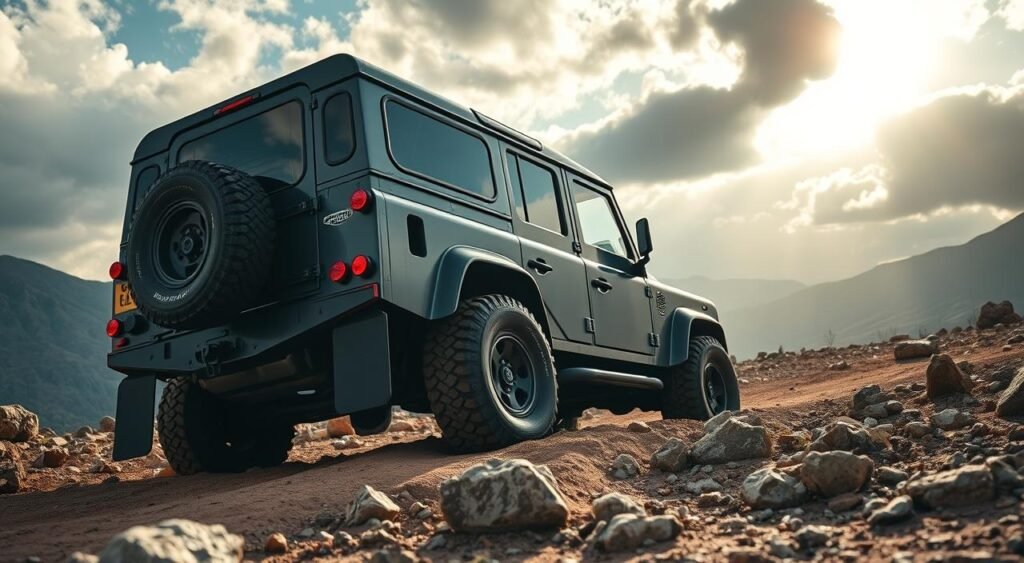
| Feature Category | Trophy Edition Specifications |
|---|---|
| Exterior Equipment | Black deployable roof ladder, side-mounted gear carrier, front and rear mud flaps |
| Wheel Configuration | 20-inch gloss black alloys with all-terrain tires |
| Interior Features | Ebony Windsor Leather seats, Trophy illuminated treadplates |
| Protection Options | Available matte protective film coating |
Design and Aesthetic Appeal
The edition is known for its unique Trophy decals and gloss black finishes. The black covers the bonnet, lower body sides, brake calipers, and rear recovery eyes. This makes the vehicle stand out while keeping its rugged look.
Performance Capabilities
The Trophy Edition is built on the Defender’s strong platform. It has advanced technology for off-road adventures. The interior is designed for comfort, making it easy to control the vehicle in tough conditions.
Whether you’re driving on rough trails or smooth highways, the Trophy Edition handles it well. It stays in control and composed in every situation.
Off-Road Excellence: The Heart of the Defender
The Land Rover Defender 110 Trophy Edition turns tough terrain into easy paths. It’s the top of rugged design, made for extreme adventures. Its off-road skills make it the top pick for the Defender Trophy competition, where drivers face tough trails and hidden drops.

All-Terrain Adventure Systems
The Trophy Edition has a raised air intake for better dust filtering in tough places. Dark rear scuff plates protect it during steep descents. Gloss black wheelarch protection keeps the body safe from debris, and the black front undershield guards against rocks and rough terrain.
Suspension and Handling
Advanced suspension tech keeps the Defender stable on uneven ground. It adjusts to different terrains, giving the best ground clearance and movement. This lets drivers overcome obstacles that other cars can’t.
Wheel and Tire Configuration
The Trophy Edition has 20-inch wheels with special all-terrain tires. These tires grip well on mud, sand, rock, and loose surfaces. The wheels and tires offer comfort on roads and top off-road performance.
| Feature | Specification | Benefit |
|---|---|---|
| Wheel Size | 20 inches | Optimal clearance |
| Tire Type | All-terrain | Multi-surface grip |
| Explorer Pack Value | $5,400 | Premium protection |
Advanced Technology Integration
The Land Rover Defender 110 Trophy combines ruggedness with advanced technology. It makes every drive better. This special edition is perfect for those who love adventure and staying connected.
Infotainment and Connectivity Features
The Trophy edition comes with Land Rover’s latest Pivi Pro infotainment system. It has an 11.4-inch touchscreen that works fast. You can connect your Apple or Android device easily.
The comfortable interior also has a top-notch Meridian sound system. It plays music like a concert, thanks to its speakers.
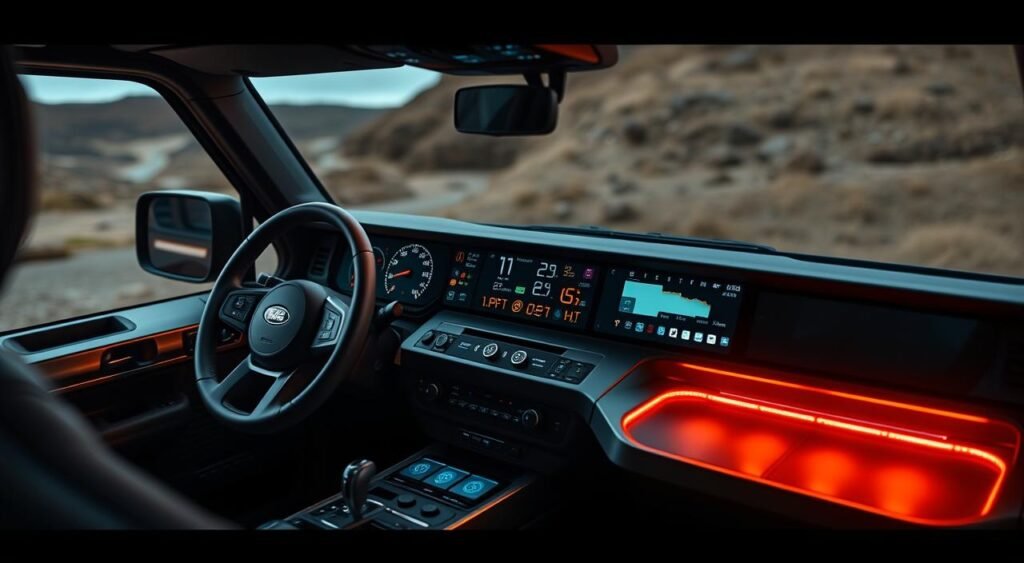
Safety Innovations
Land Rover has made the Defender Trophy very safe. It’s ready for both city streets and rough trails. The vehicle has:
- 360-degree surround cameras for complete visibility
- Emergency braking with pedestrian detection
- Advanced airbag systems throughout the cabin
- Terrain Response 2 for optimal traction control
Driver Assistance Technologies
The Trophy edition has smart driver aids for tough terrains. Adaptive cruise control keeps a safe distance on highways. The ClearSight Ground View technology lets you see under the car.
It also has lane-keeping assist and blind-spot monitoring. These features make driving safer and less tiring. They work well in the comfortable interior to help you on long trips.
Customization Options for Enthuisiasts
The Land Rover Defender 110 Trophy Edition lets you make your vehicle truly yours. It offers many ways to personalize it, blending style with practicality. This way, your Defender becomes the perfect partner for any adventure.
Exterior Customization Choices
The Trophy Edition comes with two special paint colors. Deep Sandglow Yellow is a fresh take on a classic color. It’s a nod to the Defenders of international trophy events. Keswick Green honors Land Rover’s UK roots and love for rural exploration.
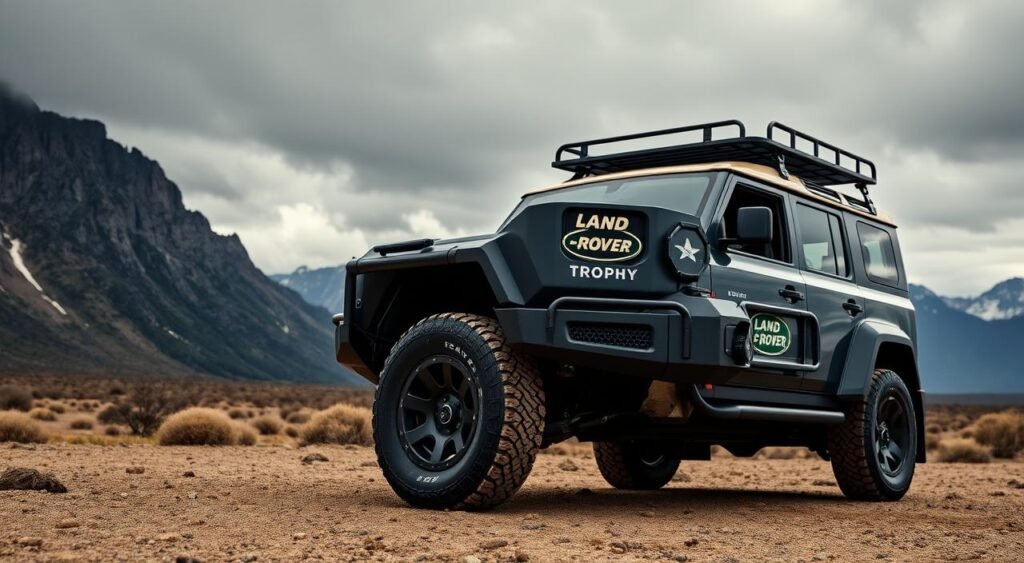
An optional matte film adds protection for off-road trips. It keeps the body safe from scratches and dirt. This keeps your Defender looking great, even after tough adventures.
Interior Personalization
The interior of the Trophy Edition is both cozy and useful. It uses top-notch materials and trim options. This lets you tailor the inside to fit your adventurous life, while keeping it stylish.
Accessory Packages Available
The Trophy Edition’s design can be improved with useful accessories:
- Expedition roof rack for extra storage
- Black deployable roof ladder for easy access
- Gloss black side-mounted gear carrier for wet gear
- Front and rear classic mud flaps
- Raised air intake for water crossings
Many of these upgrades are included with the Defender Explorer Pack. This makes the Trophy Edition a great choice for serious explorers.
Why Choose the Defender 110 Trophy for Adventure
The Land Rover Defender 110 Trophy is a top pick for those who love adventure. It has been a symbol of off-road excellence for over 70 years. The Trophy edition adds new features for those who face the toughest terrains.
Durability and Reliability
The Defender 110 Trophy is built to last, using materials found in the military. Its strong chassis and weatherproof systems can handle extreme conditions. Land Rover tests these vehicles in harsh conditions to ensure they can withstand years of use.
Many owners have driven their Defenders for over 200,000 miles without needing major repairs. This shows the vehicle’s reliability.
Community and Brand Loyalty
Defender owners form a global community that shares stories and tips. The Trophy competition brings them together through challenges and physical tests. This builds strong bonds among them.
Land Rover works with Tusk to create expeditions that protect wildlife. These expeditions give owners unique experiences in Africa. This shows the brand’s commitment to adventure and conservation.
Customer Testimonials and Reviews
Real owners love the Defender 110 Trophy for its off-road skills and daily use. Adventure photographers and families use it for trips. Professional guides choose it for its ability to handle rough terrain while keeping passengers comfortable.
The Defender 110 Trophy is perfect for serious adventurers. Check it out to see why it’s the top choice for many.
FAQ
What is the starting price of the Land Rover Defender 110 Trophy Edition?
The Defender 110 Trophy Edition starts at £89,810 OTR in the UK. This is about 1,000. It comes with the Explorer Pack, worth ,400, as standard.
What are the exclusive color options available for the Trophy Edition?
You can get the Trophy Edition in two special colors. Deep Sandglow Yellow is a modern take on a classic Defender color. Keswick Green celebrates Defender’s UK heritage.
What off-road capability features come standard on the Trophy Edition?
It comes with gloss black 20-inch alloy wheels and all-terrain tires. It also has a raised air intake and dark rear scuff plate. Plus, there’s gloss black wheelarch protection and classic mud flaps for better off-road performance.
What is the Defender Trophy competition?
The Defender Trophy is a global adventure competition. It’s inspired by classic events. Over 50 countries are participating, with a global final in Africa in 2026. Winners will join a conservation mission with Tusk.
What advanced technology and interior features does the Trophy Edition include?
It has Ebony Windsor Leather seats and Trophy illuminated treadplates. The interior also features an exposed Cross Car Beam in the same color as the exterior. It has unique laser-etched endcaps with Trophy branding.
What rugged design elements distinguish the Trophy Edition?
The Trophy Edition has a gloss black finish on the bonnet and bodyside. It also has black brake calipers and rear recovery eyes. Trophy decals and badging give it a bold look.
What optional accessories are available for the Trophy Edition?
You can add an expedition roof rack for extra storage. There’s also a black deployable roof ladder and a gloss black side-mounted gear carrier. Matte protective film is available for bodywork protection.
Who can participate in the Defender Trophy competition?
You must be over 23, able to swim 50 meters, and eligible to drive internationally. You also need to speak fluent English. Local events start in summer, with national finals in spring to choose global finalists.
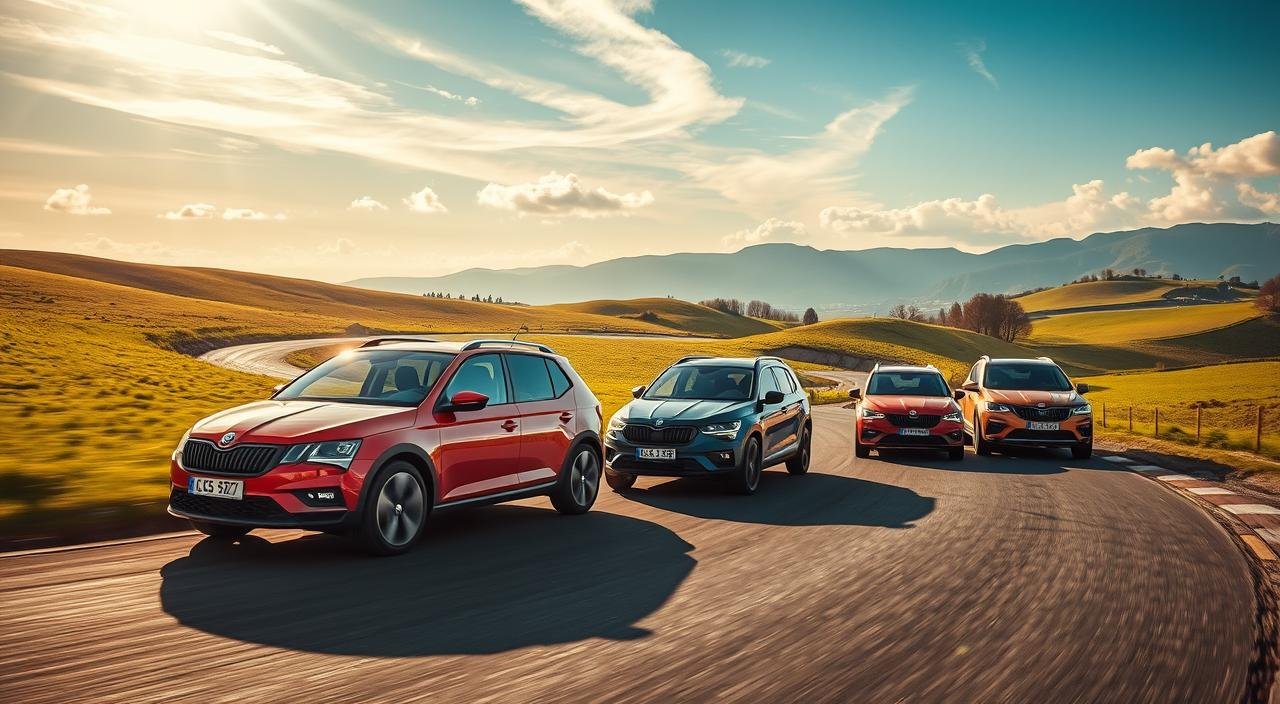
Jun
What happens when you test four Skoda models in one day? We found out in Alibaug, Maharashtra. The brand showed its range from the compact Kushaq to the Kodiaq.
The adventure started with a unique touch. We boarded a Ro-Ro ferry from South Mumbai. The cabins were named after Skoda models like Superb, Slavia, and Kushaq. This ferry service has been sponsored by Skoda for years, showing what the brand stands for in India.
At the test venue, a special tarmac track awaited us. It had Autocross, Moose Test, Slalom, and handling courses. Each challenge was designed to show off the Skoda lineup’s abilities.
Throughout the day, we drove the new Kylaq, the Kushaq, the Slavia, and the Kodiaq. It was clear that Skoda makes cars for more than just getting from point A to B. These vehicles are made for driver engagement and a real connection between driver and car.
Key Takeaways
- Tested four Skoda models in Alibaug including Kylaq, Kushaq, Slavia, and Kodiaq
- Unique ferry experience with Skoda-branded cabins demonstrates brand commitment
- Professional test track featured Autocross, Moose Test, and Slalom challenges
- Each model offers distinct driving characteristics suited to different needs
- Skoda focuses on driver engagement, not just transportation
- The lineup ranges from compact SUVs to full-size family vehicles
Introduction to Our Skoda Experience
Our day with Skoda began at the Taj Gateway. We gathered for a special test drive event. Skoda showed us their full lineup, with expert drivers to guide us.
This chance let us see Skoda performance in various models in one day.
Overview of the Day
The day started with a talk about Skoda’s top model. Then, we enjoyed a fancy five-course lunch. The cars were ready, looking great in the sun.
Drivers told us about safety and the routes we’d take. Then, we set off on our car adventure.
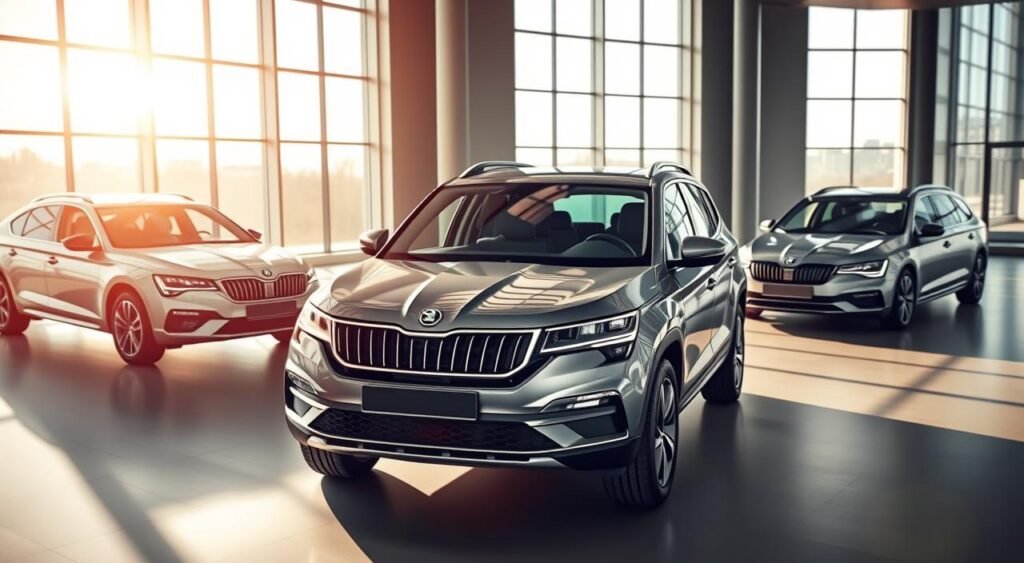
What to Expect from Each Model
Skoda showed us their wide range of cars. The Kylaq had a small but powerful engine. It made 114 bhp and 178 Nm of torque.
The Slavia had a big 1.5-liter engine, making 148 bhp. The Kodiaq, their top SUV, had a strong 2.0-liter engine, making 201 bhp.
Brief History of Skoda in India
Skoda’s journey in India has changed a lot. They used to be seen as a high-end European brand. Now, they aim to reach more people.
The new Kylaq shows this change. Today, Kushaq review chances show Skoda wants to engage car lovers. They offer more than just a ride.
Skoda Kushaq: The Compact SUV
The Kushaq is Skoda’s new entry in the compact SUV market in India. It offers a fun drive that’s perfect for city life and exciting performance. Our tests showed it’s a standout among city cars.
Design and Features
The Kushaq has Skoda’s latest design with sharp lines and a bold front. It’s small but looks big on the road. Inside, you’ll find useful features like:
- 10-inch touchscreen infotainment system
- Digital instrument cluster
- Ventilated front seats
- Wireless charging pad
- Six airbags as standard

Engine Performance and Handling
Our tests showed the Kushaq’s great performance. The steering is very responsive, reaching almost 100 kmph fast. It also brakes well.
In the Moose Test, it showed great stability and sharp cornering. The Slalom course proved it handles well, better than many SUVs. While it may not be the most fuel-efficient, it makes up for it with a fun drive.
Driving Experience in City Conditions
The Kushaq is great for city driving. It’s small but easy to park, thanks to its responsive steering. The suspension is comfy but also handles well.
It’s safe, with lots of safety features. Even though it’s not a Kodiaq review, it has similar quality but is more suited for city driving.
Skoda Slavia: The Sedan Alternative
The Slavia adds elegance to Skoda’s lineup as a four-door sedan. It shows sedans are important, even with SUVs being popular. Our test drive showed it’s a great choice for those who love driving.
Interior Comfort and Technology
The cabin fits four adults comfortably. It’s filled with premium materials. The 10-inch touchscreen is easy to use with wireless Android Auto and Apple CarPlay.
The front seats are great for spirited drives. Rear passengers have enough legroom and headroom. The digital instrument cluster shows clear graphics.
The climate control keeps the car comfortable. There are smart storage solutions and USB ports for charging devices.

Performance on the Open Road
The 1.5-liter TSI EVO engine responds quickly. Turbo lag is minimal, even at low speeds. The sedan’s low stance makes it stable in corners.
Highway driving is smooth, with little wind noise. The suspension balances comfort and control. This makes the driving experience rewarding.
Comparison with Kushaq
Track testing showed the Slavia’s better stability. Its steering is more precise. The Kushaq is playful, while the Slavia is methodical in corners.
Skoda pricing makes both models affordable. The sedan is for driving enthusiasts. The SUV is for families. Both meet their purpose well in Skoda’s lineup.
Skoda Karoq: The Mid-Size SUV
The Skoda Karoq is a key player in the SUV lineup. It’s the perfect size, between the compact Kushaq and the seven-seat Kodiaq. Families will love its roomy interior and sleek design.
Styling and Practicality
The Karoq is known for its Skoda features. It has sharp lines and a practical design. It offers:
- Split headlights with LED technology
- 18-inch alloy wheels on higher trims
- Flexible rear seats that slide and recline
- Boot space ranging from 521 to 1,630 liters
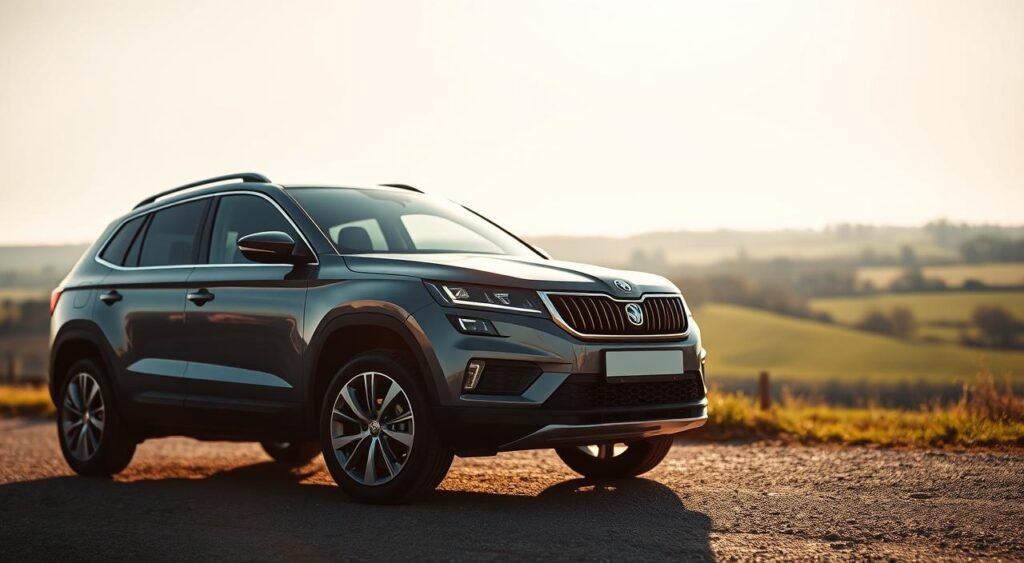
Safety Features and Ratings
Safety is a top priority in the Karoq. It comes with nine airbags, electronic stability control, and hill-hold assist. Euro NCAP gave it a five-star rating for its Skoda performance in crash tests.
It also has advanced driver assistance systems. These include blind-spot detection and rear traffic alert.
Comfort for Long Drives
Long drives are a breeze in the Karoq. Its seats are comfy, and the cabin is quiet. The suspension is great for both comfort and handling.
Climate control keeps everyone cozy. The 8-inch touchscreen adds to the fun. With Skoda fuel efficiency at 15-17 km/l, trips are affordable. The Karoq is perfect for families who want luxury without the high cost.
Skoda Kodiaq: The Ultimate Family SUV
The Kodiaq is Skoda’s top SUV in India. It costs Rs 50 lakh and is great for families. The L&K variant we tested had 2,700 kilometers on it. Its black paint showed mud from adventures.
Spaciousness and Family-Friendly Features
The Kodiaq has seven seats, perfect for big families. The third row is spacious for kids and teens. It has features like automatic door guards and umbrella holders.
Space dividers help organize cargo. Touch-operated lights make it easy to access at night.
Advanced Technology and Infotainment
The Kodiaq has impressive tech for its price. It has a 360-degree camera system and park assist. The digital cockpit shows important info, and massage seats reduce fatigue.
During our test, hill descent control handled steep slopes well. The all-wheel-drive system was smooth on rough terrain. It also braked well, even when one wheel hit gravel.
Final Thoughts and Recommendations
The Kodiaq offers great value at Skoda’s pricing. It’s like a luxury German SUV but cheaper. It gets 12 kilometers per liter, which is impressive for its size.
Skoda’s safety ratings are high, with five-star crash test results. For families wanting space, tech, and off-road ability, the Kodiaq is a good choice. It’s practical for daily use and fun for weekend adventures.
FAQ
What makes the Skoda Kushaq stand out in the compact SUV segment?
The Kushaq shines with its quick steering and real driver connection. It brakes confidently from high speeds and handles well in tight turns. It has a 1.0-litre turbo-petrol engine, making it good for city driving and fun road trips.
How does the Skoda Slavia compare to the Kushaq in terms of driving experience?
The Slavia sedan feels more stable and responsive. Its engine is more powerful and reacts faster than the Kushaq’s. The sedan also has better aerodynamics and fits four adults comfortably.
What are the off-road capabilities of the Skoda Kodiaq?
The Kodiaq is a luxury SUV that’s surprisingly good off-road. It tackles steep hills, descends safely, and handles rough terrain well. Its AWD system and braking performance are top-notch.
What are the key Skoda safety ratings across the lineup?
Skoda focuses on keeping passengers safe in all its cars. They come with many safety features like airbags and advanced systems. The Kodiaq also has features like 360-degree cameras for extra safety.
How does Skoda pricing compare to competitors in each segment?
Skoda’s prices are competitive. The Kylaq is affordable, while the Kushaq and Slavia are priced well in their segments. The Kodiaq offers luxury at a lower cost, making it a great value.
What is the fuel efficiency across the Skoda car lineup?
Fuel efficiency varies by model. The Kodiaq gets 12 kmpl despite its size. The Kushaq balances performance and fuel use. The Slavia’s engine is efficient thanks to its design.
Which Skoda model is best for family use?
The Kodiaq is the top choice for families. It has seven seats and is practical for kids or teens. The Karoq is a good option for smaller families, with more space than the Kushaq.
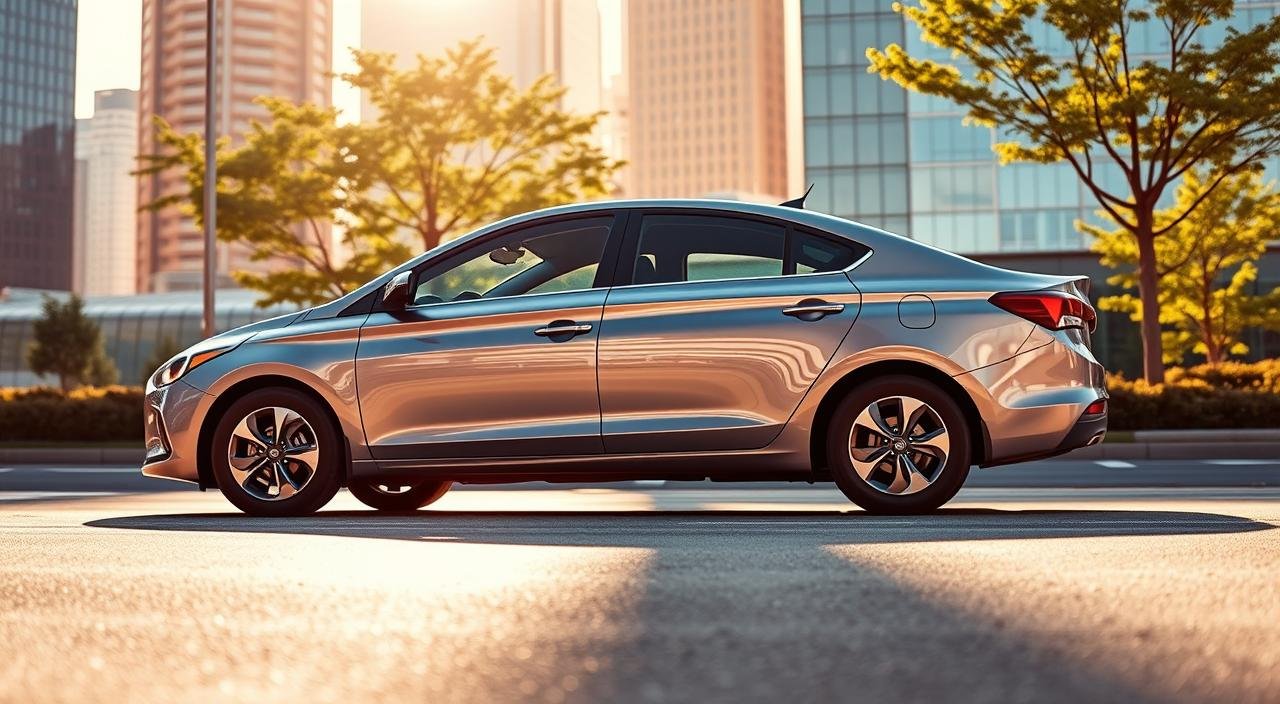
Jun
Looking for a premium sedan but worried about the cost? Hyundai has a solution that might change your mind. The Hyundai Verna, a favorite in India, now has a new affordable premium variant. It offers top-notch features without the high price.
The new SX Plus variant falls between the SX and SX(O) trims. It offers a mix of luxury and value. It comes with a 1.5L petrol engine that gives 115PS of power and 144Nm of torque. You can choose between manual and CVT transmissions.
This new model makes premium features more accessible. It has ventilated and heated front seats, plush leatherette upholstery, and an 8-speaker Bose sound system. The Hyundai Verna SX Plus is priced lower than the top-end variant by over Rs 1 lakh.
Key Takeaways:
- Hyundai introduces an affordable premium variant of the Verna sedan in India
- The new SX Plus trim offers high-end features at a more accessible price point
- 1.5L petrol engine available with manual and CVT transmission options
- Ventilated seats, leatherette upholstery, and Bose sound system now more attainable
- Significant price reduction compared to the top-end SX(O) variant
Introduction to the Hyundai Verna Premium Variant
The Hyundai Verna has been a hit in India, blending style, comfort, and performance. The new premium variant aims to attract more people to the Verna.
Overview of the New Variant
The new Hyundai Verna premium variant, called the SX Plus, is a middle ground. It offers luxury features without the high cost of the top model.
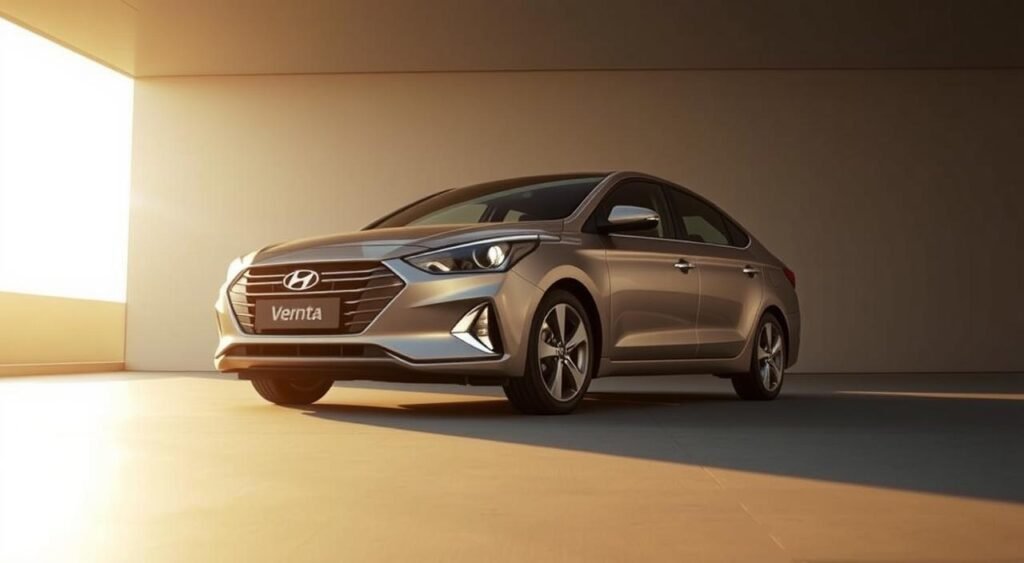
Significance of Affordability
Hyundai knows how important affordability is in India. The Verna SX Plus variant brings more value and features to more people. It makes luxury more affordable for those on a budget.
The new Hyundai Verna premium variant is priced well. Here’s a comparison:
| Variant | Price (Ex-Showroom, Delhi) |
|---|---|
| Hyundai Verna SX | ₹ 11.99 Lakh |
| Hyundai Verna SX Plus | ₹ 13.49 Lakh |
| Hyundai Verna SX(O) | ₹ 14.99 Lakh |
Target Audience for the New Model
The new Hyundai Verna premium variant is for:
- Car enthusiasts who want luxury without spending too much
- Young professionals who need a stylish and feature-rich sedan
- Families looking for a spacious and comfortable car at a good price
Hyundai hopes the Hyundai Verna SX Plus will appeal to a wide range of customers. They want to offer premium features at a reasonable cost.
Key Features of the Hyundai Verna Premium
The Hyundai Verna Premium comes with many impressive features. These enhance its performance, safety, and entertainment. Let’s explore what makes this sedan a standout choice.
Engine Performance and Efficiency
The Verna Premium has a 1.5L naturally aspirated petrol engine. This engine gives 115PS of power and 144Nm of torque. It ensures smooth acceleration and responsive handling.
The Verna Premium is also great on fuel. The manual version gets 18.6 kmpl, and the CVT automatic gets 19.6 kmpl. This makes it one of the most fuel-efficient sedans in its class.
Advanced Safety Features
Hyundai has focused on safety in the Verna Premium. It comes with many protective features:
- 6 airbags for all-around occupant protection
- Front and rear parking sensors to assist in tight spots
- Hill start assist to prevent rolling back on inclines
- Rear parking camera for improved visibility while reversing
- Electronic parking brake for secure stationary holding
- Tire pressure monitoring system (TPMS) to warn of low tire inflation
These safety features offer peace of mind to drivers and passengers. They make the Verna Premium a safe choice for everyone.
State-of-the-Art Infotainment System

The Verna Premium’s interior is enhanced by its 8-inch touchscreen infotainment system. It supports Android Auto and Apple CarPlay. This allows for hands-free calls, navigation, and music playback.
The display is crisp and responsive. Accessing the Verna’s features is easy. Whether streaming music, following directions, or just enjoying the ride, the system makes driving better.
Pricing Structure and Competitive Analysis
The new Hyundai Verna Premium variant has changed the compact sedan market. It combines great features with affordable prices. Let’s explore the pricing and how it stacks up against other models and competitors.
Cost Comparison with Previous Models
The Hyundai Verna Premium sits between the SX and SX(O) trims. It offers more features at a higher price. The price increase of Rs 64,000 is worth it for the extra features. Here’s a look at the manual and automatic versions:
| Variant | Manual | Automatic |
|---|---|---|
| SX | Rs 13.15 lakh | Rs 14.40 lakh |
| SX Plus (Premium) | Rs 13.79 lakh | Rs 15.04 lakh |
| SX(O) | Rs 14.65 lakh | Rs 15.90 lakh |
The Premium variant is a great value. It offers many features at a lower price than the SX(O) trim.
Comparison with Competitors in the Segment
The compact sedan market is very competitive. Cars like the Volkswagen Virtus, Honda City, and Skoda Slavia are all vying for attention. How does the Hyundai Verna Premium compare? Let’s find out:
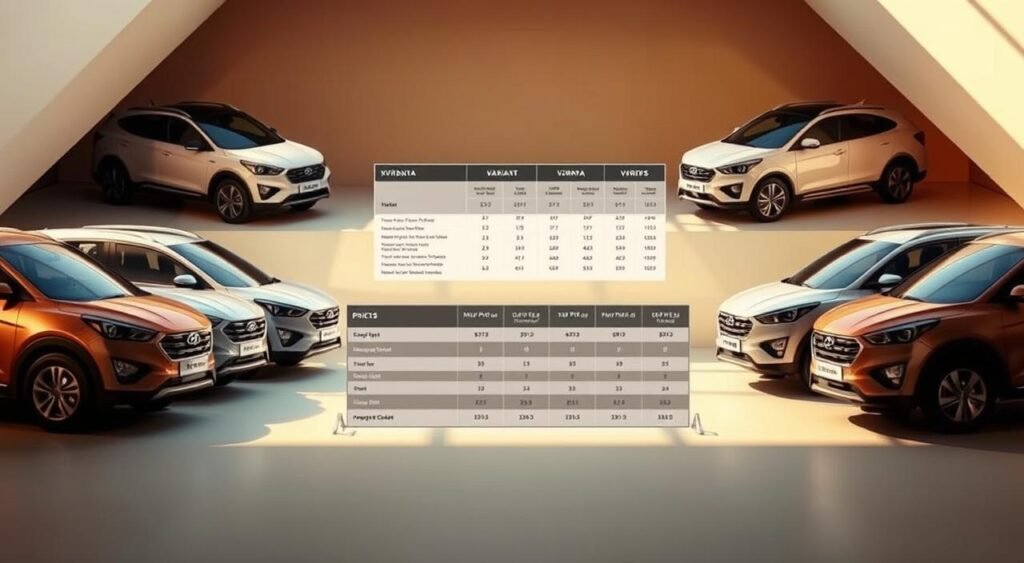
The Verna Premium is priced lower than its rivals but offers similar features. It’s a great choice for those wanting premium features without spending too much.
| Model | Base Price (Ex-showroom) | Key Features |
|---|---|---|
| Hyundai Verna Premium | Rs 13.79 lakh | Wireless charger, ventilated seats, digital cluster |
| Volkswagen Virtus Highline | Rs 14.27 lakh | Digital cockpit, wireless charger, rear AC vents |
| Honda City VX | Rs 14.11 lakh | Lane watch camera, sunroof, 8-inch touchscreen |
| Skoda Slavia Style | Rs 14.39 lakh | Ventilated seats, wireless charger, 10-inch touchscreen |
In conclusion, the Hyundai Verna Premium’s pricing and cost comparison with competitors show its strong position. It offers a great mix of affordability and premium features. This makes it a top choice for those looking for value in the compact sedan market.
Design and Aesthetics of the New Variant
The Hyundai Verna’s new variant elevates the sedan’s design and aesthetics. Its sleek lines, bold styling, and premium features make it a standout on the road.
Exterior Design Enhancements
The exterior of the Hyundai Verna’s new variant is impressive. The LED headlights and LED DRLs offer great visibility and add sophistication. The 16-inch alloy wheels add a sporty look.
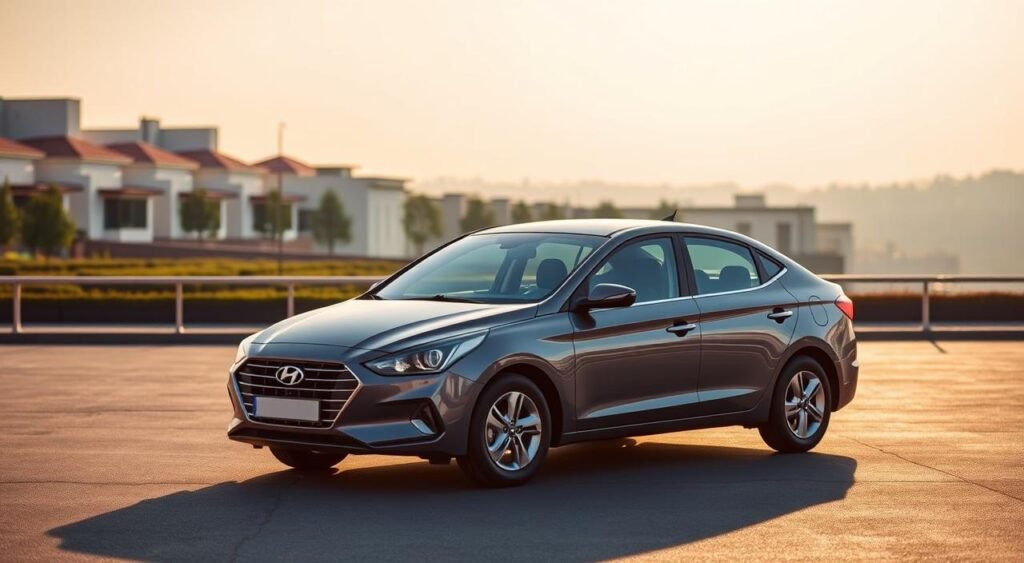
The LED tail lights at the rear give the Verna a modern look. The exterior design elements work together to create a unique and eye-catching appearance.
Interior Comfort and Technology Upgrades
Inside the Hyundai Verna’s new variant, you’ll find luxury and comfort. The interior features a dual-tone black and beige theme. The leatherette-wrapped steering wheel and gear lever add a premium feel.
Comfort is a key focus, with features like a single-pane sunroof and automatic climate control. The ambient lighting, wireless phone charger, and cooled glovebox add convenience. They ensure your devices stay charged and your drinks stay cool.
Technology is a highlight in the Hyundai Verna’s new variant. The infotainment system offers seamless connectivity and entertainment. The cruise control function makes long drives more comfortable.
Hyundai Verna Premium: Performance Review
The Hyundai Verna Premium is a great mix of performance and value. It’s a sleek sedan that offers a smooth drive. It’s perfect for those who want a good car without spending too much.

The Verna Premium has a 1.5-liter engine under the hood. It makes 115 PS of power and 144 Nm of torque. This means it accelerates well and cruises smoothly.
Handling and Ride Quality
The Verna Premium handles well, thanks to its suspension. It stays stable and smooth, even on tight turns. The steering is precise, making driving feel confident.
The ride quality is also great. It’s comfortable but not too soft. The cabin is quiet, making the drive even better.
Fuel Efficiency Ratings
The Verna Premium is known for its good fuel economy. It comes with manual and automatic transmissions. This suits different driving styles.
| Transmission | ARAI-Certified Mileage |
|---|---|
| Manual | 18.6 kmpl |
| Automatic (CVT) | 19.6 kmpl |
Its fuel efficiency is among the best in its class. This makes the Verna Premium a smart choice for daily driving and long trips.
Customer Feedback on the Hyundai Verna
The new Hyundai Verna SX Plus has caught a lot of attention. Many people have shared their thoughts and experiences. This car is seen as an affordable premium option, getting both praise and criticism from buyers in India.
Positive Reception and Praise
Customers love the Hyundai Verna SX Plus for its design, comfort, and tech features. They say it’s a great deal for the price. It makes luxury features more affordable.
One happy customer said, “The Hyundai Verna SX Plus is amazing. It mixes style, comfort, and tech well without costing too much. The ride is smooth, and the features are great for the price.”
Common Criticisms and Suggestions
Even with the positive feedback, some customers have shared their concerns. One big point is the lack of the 1.5L turbo-petrol engine in the SX Plus.
Another customer mentioned, “I wish the Hyundai Verna SX Plus had a bigger touchscreen and connected car tech like the top models. These would make it even better.”
Despite these points, many customers think the SX Plus is a good deal. They see it as a balance between cost and luxury features.
Hyundai is listening to what customers say about the Verna. They might make changes to improve the car and meet what people want.
The Importance of Affordability in the Automotive Market
In today’s competitive automotive market, affordability is key. Buyers want value without giving up on important features and performance. As living costs rise, they look for cars that offer the best bang for their buck.
The Hyundai Verna Premium shows how car makers meet this demand. It offers lots of features at a good price. Hyundai hopes to attract more buyers with this approach.
Trends in Consumer Preferences
People now want cars that are affordable yet packed with features. They expect safety, good fuel economy, and tech without breaking the bank. This change has made the market more competitive.
Car makers are now racing to create affordable yet feature-rich models. They aim to meet the changing needs of buyers.
How Pricing Influences Buyer Decisions
Pricing is a big factor in car buying. Buyers compare prices and features before deciding. They look for the best deal without losing out on quality.
Good pricing, like Hyundai Verna Premium’s, can sway decisions. It offers a great value, attracting those who want quality without high costs.
The importance of affordability in the automotive market cannot be overstated. As preferences change and competition grows, cars that offer value and quality will win more buyers.
Marketing Strategies for the New Variant
Hyundai is getting ready to introduce a new version of its popular sedan, the Hyundai Verna. The company has a detailed marketing plan. It includes various promotional campaigns and targets certain groups of people.
The Hyundai marketing team has come up with a plan to reach out to buyers in different ways. They will use:
- Digital ads on social media and websites
- TV commercials to show off the Verna’s design and features
- Print ads in car magazines and newspapers
- Outdoor billboards in busy places
Promotional Campaigns and Approaches
The new Hyundai Verna variant’s ads will focus on its main selling points. These include its affordable price, premium features, and great value. The ads will show how the Verna offers a luxury drive without costing too much.
Hyundai also plans to offer special deals and financing options to attract buyers. These might include:
- Introductory prices
- Low-interest loans
- Extended warranties
- Free extras or maintenance
Targeted Demographics for the Campaign
The marketing for the new Hyundai Verna will target certain groups. These include:
| Demographic | Key Characteristics | Marketing Approach | ||
|---|---|---|---|---|
| Young Professionals | Age: 25-35 | Income: Mid to High | Urban dwellers | Emphasize style, technology, and value |
| Small Families | Married couples with 1-2 children | Age: 30-45 | Income: Mid to High | Focus on safety, comfort, and spaciousness |
| Budget-Conscious Buyers | Age: 35-50 | Income: Low to Mid | Value-oriented | Highlight affordability and cost-saving features |
By focusing on these groups, Hyundai hopes to maximize the impact of its ads. They aim to attract a wide range of buyers to the new Verna variant.
Availability and Launch Timeline
The Hyundai Verna Premium variant is coming to India. It combines affordability with premium features. This new Verna is set to shake up the sedan market.
Hyundai says the Verna Premium will be available from the second week of September 2023. They’ve timed the launch for the festive season. This aims to tap into the higher demand during this time.
Expected Release Dates
Hyundai has set different release dates for the Verna Premium across India. This staggered release helps manage supply and meet demand. Here’s when you can expect it:
- North India: September 10, 2023
- South India: September 15, 2023
- East India: September 20, 2023
- West India: September 25, 2023
Distribution Strategies Across India
Hyundai has a strong plan to make the Hyundai Verna Premium available everywhere in India. They have a wide network of dealerships and service centers. These cover all big cities and towns.
People wanting to see the Verna Premium can visit their nearest Hyundai showroom. There, they can book test drives and place orders. Hyundai also has an online portal. It lets you check out the new variant’s features, specs, and prices. You can even book it online.
Future Implications for Hyundai
The launch of the new Hyundai Verna Premium variant is a big step for Hyundai in the Indian market. It shows Hyundai’s dedication to meeting the changing needs of Indian buyers. By making a premium car more affordable, Hyundai aims to win over more customers.
Potential for Expansion in the Indian Market
The Verna Premium variant is a hit in the mid-size sedan market. Its good price and many features could draw in more buyers. This could help Hyundai grow its sales and market share in India.
| Year | Hyundai Market Share in India |
|---|---|
| 2018 | 16.4% |
| 2019 | 17.3% |
| 2020 | 17.4% |
| 2021 (Projected) | 18.5% |
Long-term Strategy for the Hyundai Verna Lineup
The Verna Premium variant is part of Hyundai’s long-term strategy for the Verna lineup. Hyundai plans to keep the Verna competitive by updating it regularly. They might add new engines, advanced tech, and improve the design.
- Introduction of new engine options for enhanced performance and efficiency
- Integration of advanced technology features to keep pace with changing market dynamics
- Further design enhancements to maintain the Verna’s modern and stylish appeal
Hyundai is ready to take advantage of the market’s growth. The Verna Premium shows Hyundai’s focus on making cars that offer great value. This approach helps Hyundai meet the needs of Indian buyers.
Conclusion: The Impact of the Affordable Premium Variant
The Hyundai Verna SX Plus variant is a big change in the Indian car market. It mixes luxury with great value, making it a top pick for many. Hyundai shows it gets what Indian buyers want with this new model.
Summary of Key Points
The Hyundai Verna SX Plus has lots of cool features. It looks great and feels luxurious inside. It also has top-notch safety and tech, making driving fun and safe.
Its price is also a big plus. It’s a great deal in the mid-size sedan market. This makes it a standout choice for many.
Final Thoughts on the Hyundai Verna Premium
Hyundai keeps improving and setting new standards in cars. The Verna SX Plus shows Hyundai’s dedication to quality. It’s a game-changer in India, appealing to those who want luxury without breaking the bank.
With its amazing features, good price, and strong brand, the Hyundai Verna SX Plus is changing the game. It’s making Hyundai a leader in India’s car market.
FAQ
What is the new variant introduced in the Hyundai Verna lineup?
Hyundai has added a new mid-spec SX Plus variant to the Verna lineup. It sits between the SX and SX(O) trims.
What engine options are available in the Hyundai Verna SX Plus variant?
The SX Plus comes with a 1.5L naturally aspirated petrol engine. It has 115PS of power and 144Nm of torque. You can choose between a manual and CVT transmission.
How does the introduction of the Hyundai Verna SX Plus variant make premium features more accessible?
This new variant makes features like ventilated and heated front seats more affordable. It also includes leatherette seat upholstery and an 8-speaker Bose sound system. These features are now available at a cost of over Rs 1 lakh less than the SX(O) variant.
What is the price difference between the Hyundai Verna SX Plus and the SX variant?
The Hyundai Verna SX Plus costs Rs 64,000 more than the SX variant. The manual starts at Rs 13.79 lakh, and the automatic at Rs 15.04 lakh (ex-showroom).
What are the key exterior design features of the Hyundai Verna SX Plus?
The Hyundai Verna SX Plus has a striking look. It features LED headlights, LED DRLs, LED tail lights, and stylish 16-inch alloy wheels.
What are the fuel efficiency figures for the Hyundai Verna SX Plus?
The manual version of the Hyundai Verna SX Plus has an ARAI-certified mileage of 18.6kmpl. The CVT version delivers 19.6kmpl.
How has the Hyundai Verna SX Plus been received by customers?
Customers have welcomed the Hyundai Verna SX Plus variant. They appreciate the more affordable access to premium features.
What are the common criticisms of the Hyundai Verna SX Plus?
Some critics say the SX Plus lacks the 1.5L turbo-petrol engine. They also miss features like a larger touchscreen and connected car tech, found in higher trims.
When will the Hyundai Verna SX Plus be available for purchase?
The Hyundai Verna SX Plus is now available for purchase in India. Deliveries are expected to start right away.
How can customers experience the Hyundai Verna SX Plus in person?
Customers can visit their nearest Hyundai showroom. There, they can see the Verna SX Plus, book a test drive, and place their orders.
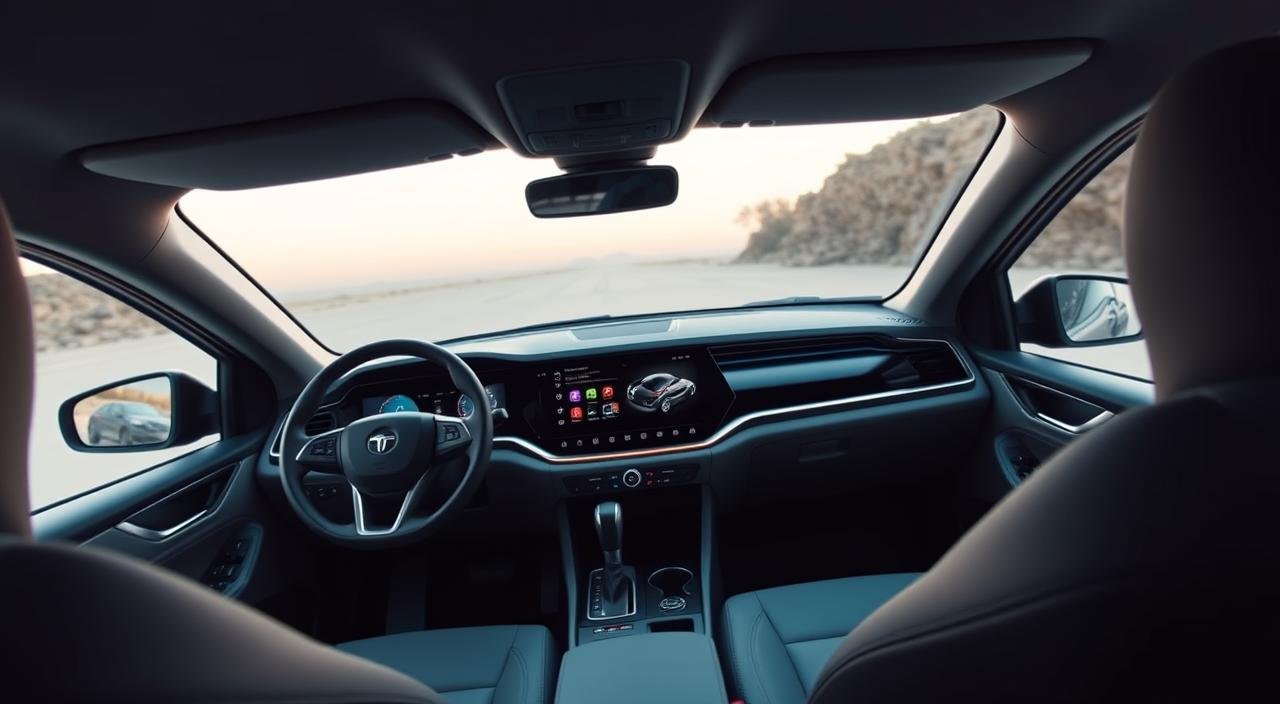
Jun
Imagine driving a Tata Harrier and enjoying the perks of an electric vehicle. The 2025 Harrier EV is here, blending the SUV’s rugged appeal with green tech. But what makes this electric model different from the traditional one?
Tata is all about going green with the Harrier EV. It comes with top-notch features that boost your drive and help the planet. You’ll find extended range, cool infotainment, eco-friendly materials, and smart safety features in the 2025 Harrier EV. It’s set to change the game in electric vehicles.
As the launch nears, car lovers and eco-friendly folks are excited. They want to know what makes the 2025 Tata Harrier EV so unique. Let’s explore the special features that will win your heart. We’ll also see how it compares to its gas-powered sibling.
Key Takeaways:
- The 2025 Harrier EV combines Tata’s popular SUV design with eco-friendly electric technology
- Unique features set the electric version apart from the regular Harrier
- Extended range, advanced infotainment, sustainable materials, and smart safety features are key highlights
- Tata’s commitment to sustainability is evident in the Harrier EV’s design and technology
- Car enthusiasts and environmentally conscious consumers eagerly await the launch to experience the electric SUV’s special features
An Overview of the 2025 Harrier EV
Tata Motors is set to change the Indian car market with the 2025 Harrier EV. This electric vehicle shows future technology and meets the needs of those who care about the environment. It promises a unique driving experience and helps make the future greener.
The Tata Harrier has been a hit among SUV fans. Switching to electric is a big step for the company towards green cars. Tata Motors wants to cut down on carbon emissions and give customers a green option without losing on style or power.
Brief Introduction to the Tata Harrier Lineup
The Tata Harrier lineup is known for its bold look, strong performance, and cool features. The Harrier EV is set to take the series even higher. Even though it looks like the diesel version, the real excitement is inside.

The Transition to Electric: Why It Matters
Switching to electric cars is key to fighting climate change and using less oil. The Harrier EV is a big step for Tata Motors towards being green. Electric cars don’t pollute, are quieter, and smoother, making them great for those who care about the planet.
Anticipated Launch Dates and Availability
People are excited for the 2025 Harrier EV’s launch. The exact date isn’t set, but it’s expected soon. Tata Motors will first sell it in big cities and then in other areas.
| Variant | Expected Launch | Key Features |
|---|---|---|
| Harrier EV Base | Q2 2025 | Enhanced Range, Eco-Friendly Design |
| Harrier EV Premium | Q3 2025 | Advanced Infotainment, Smart Autonomy |
| Harrier EV Signature | Q4 2025 | Luxury Interiors, Cutting-Edge Technology |
The 2025 Harrier EV shows Tata Motors’ focus on desired improvements and new ideas. With its long range, cool features, and green design, it’s set to change the SUV world in India.
What Makes the 2025 Harrier EV Stand Out
The Tata Harrier EV is set to change the Indian electric SUV market. It comes with new features and tech. It’s different from the diesel version in many ways.
Key Electric Vehicle Advantages
The Tata Harrier EV is an all-electric SUV. It has many benefits over gas cars. It doesn’t have a tailpipe, so it’s better for the environment. It also costs less to run because it uses electricity.

Advanced Technology Compared to the Regular Harrier
The Tata Harrier EV has more tech than the diesel version. Some upgrades include:
- Larger 14.53-inch touchscreen infotainment system with Samsung Neo QLED display
- Digital IRVM with integrated dashcam for continuous recording
- Increased boot space of 502 liters, plus an additional frunk storage
- New electrical architecture enabling over-the-air (OTA) updates
- Voice command functionality for enhanced convenience
- 540-degree surround view camera for improved visibility
- Level 2 Advanced Driver Assistance Systems (ADAS) for enhanced safety
Here’s a table showing the main differences between the Tata Harrier EV and the regular Harrier:
| Feature | Tata Harrier EV | Regular Harrier |
|---|---|---|
| Powertrain | All-electric | Diesel |
| Touchscreen Size | 14.53 inches | 8.8 inches |
| Boot Space | 502 liters + frunk | 445 liters |
| OTA Updates | Yes | No |
| ADAS | Level 2 | Not available |
Feature 1: Enhanced Range and Battery Life
The 2025 Tata Harrier EV is set to impress with its range and battery. It’s built on a modified version of the diesel Harrier’s platform, called Acti.ev. It will come with two battery packs: 65kWh and 75kWh LFP batteries.
The 65kWh model has a single 238hp rear motor. The 75kWh version adds a 158hp front motor for all-wheel drive. This gives a combined 313hp and 504Nm of torque. The high battery capacity means an amazing driving range.
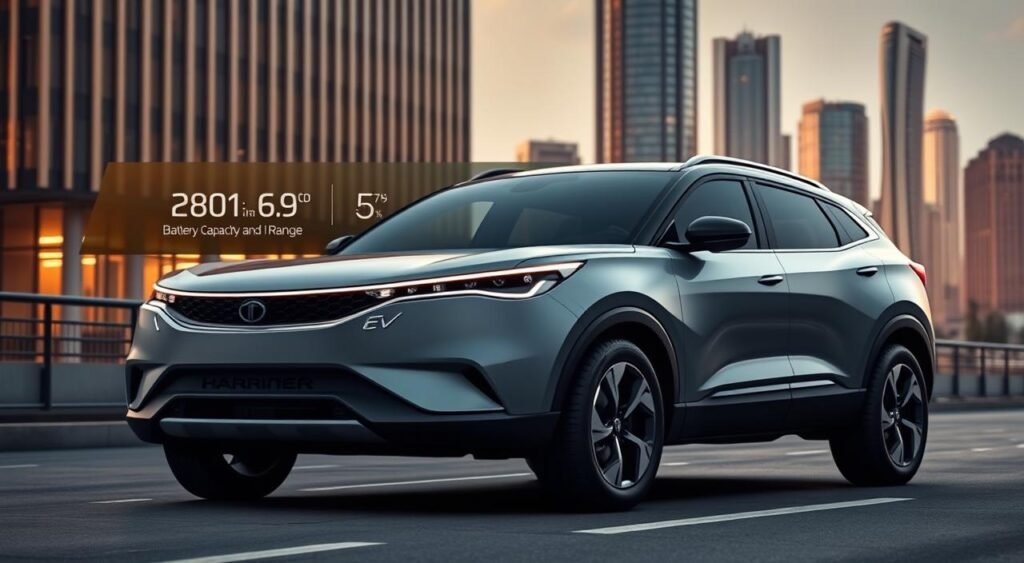
The Harrier EV has a certified range of 622-627km on a single charge. This is a big jump from the regular Harrier’s fuel efficiency. It’s a great option for those wanting to cut down on carbon emissions and save on fuel.
Charging Time and Convenience
The Harrier EV also offers easy charging options. With a 7.2kW AC charger, it takes about 10.7 hours to fully charge. For a quick boost, a 120kW DC fast charger can fill up the battery from 20% to 80% in 25 minutes. This adds 250km of range in just 15 minutes.
This combination of long range and fast charging makes the Tata Harrier EV a smart choice. It’s perfect for daily drives and long trips, tackling common electric vehicle concerns.
Feature 2: Cutting-Edge Infotainment System
The 2025 Tata Harrier EV is set to change the user experience with its advanced infotainment system. It builds on the 12.3-inch unit in the regular Harrier with a bigger, clearer 14.5-inch touchscreen display. This screen uses Samsung’s Neo QLED technology for better clarity and color, making the interface more engaging for everyone.
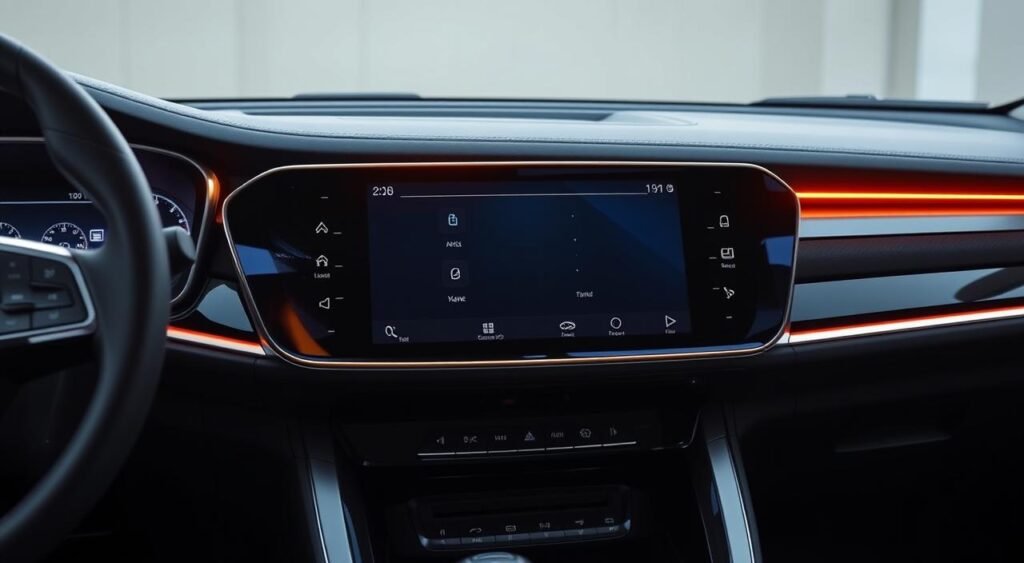
The regular Harrier and the EV model both have connected car tech. This tech combines navigation, entertainment, and vehicle info. Plus, users can enjoy wireless Android Auto and Apple CarPlay for easy smartphone integration and app access.
Speculated Upgrades Over the Current Model
Rumors hint at new features for the Harrier EV’s infotainment system. One expected feature is “Boss Mode,” which lets second-row passengers control climate and audio settings.
Another rumored upgrade is a digital IRVM (Inside Rear View Mirror) with dashcam. This feature boosts safety by recording drives and provides a clear rear view, even in dark places.
Importance of User Experience in EVs
Electric vehicles are becoming more popular, and a great user experience is key. The 2025 Tata Harrier EV’s infotainment system aims to deliver just that. It offers a tech-savvy interface that matches the vehicle’s eco-friendly nature.
Tata Motors focuses on easy controls, sharp visuals, and connected car features. The Harrier EV’s system is set to be a top choice in the market. It makes electric driving more fun and accessible for tech lovers.
Feature 3: Sustainable Materials and Eco-Friendly Design
The 2025 Tata Harrier EV is leading the way towards a greener future. It uses sustainable materials and has an eco-friendly design. Tata Motors is at the forefront of green technology in India.
The Shift Towards Sustainable Manufacturing
The Harrier EV is made to cut down on carbon emissions and reduce its environmental impact. Tata Motors has adopted sustainable manufacturing methods. These include:
- Using recycled and recyclable materials in the vehicle’s construction
- Optimizing energy efficiency in the manufacturing process
- Reducing waste and promoting responsible resource management
How Eco-Friendly Features Enhance Appeal
The eco-friendly features of the 2025 Harrier EV make it appealing to those who care about the environment. It has:
| Feature | Benefit |
|---|---|
| Zero tailpipe emissions | Reduces carbon footprint and improves air quality |
| Regenerative braking | Recovers energy during braking, increasing efficiency |
| Eco-friendly interior materials | Uses sustainable fabrics and recycled plastics, reducing waste |
The Tata Harrier EV is a hit with buyers who value the environment. It shows that you can have performance, style, and be eco-friendly. As more people choose green technology, the Harrier EV is leading India’s electric vehicle movement.
Feature 4: Smart Autonomy and Safety Features
The 2025 Tata Harrier EV brings safety and convenience to new heights. It has smart autonomous features and a top-notch safety suite. This electric version builds on the Harrier’s strong features, adding cutting-edge tech for better driving and safety.
Autonomous Driving Capabilities
The Harrier EV shines with its advanced driver assistance systems (ADAS). Auto Park Assist makes parking easy, whether parallel or perpendicular. Summon Mode lets you call your car from a parking spot, perfect for busy areas.
It also has Off-road Assist for low-speed control on tough terrains. This system keeps the SUV steady and grippy, making off-road driving smoother.
Enhanced Safety Suite in Electric Vehicles
The Harrier EV focuses on safety with its wide range of features. It comes with a 540-degree camera system for a full view around you. This is great for off-road driving, helping you avoid obstacles.
The Transparent Mode uses cameras to show what’s under the car. It helps you see the terrain and avoid dangers, boosting your safety and confidence.
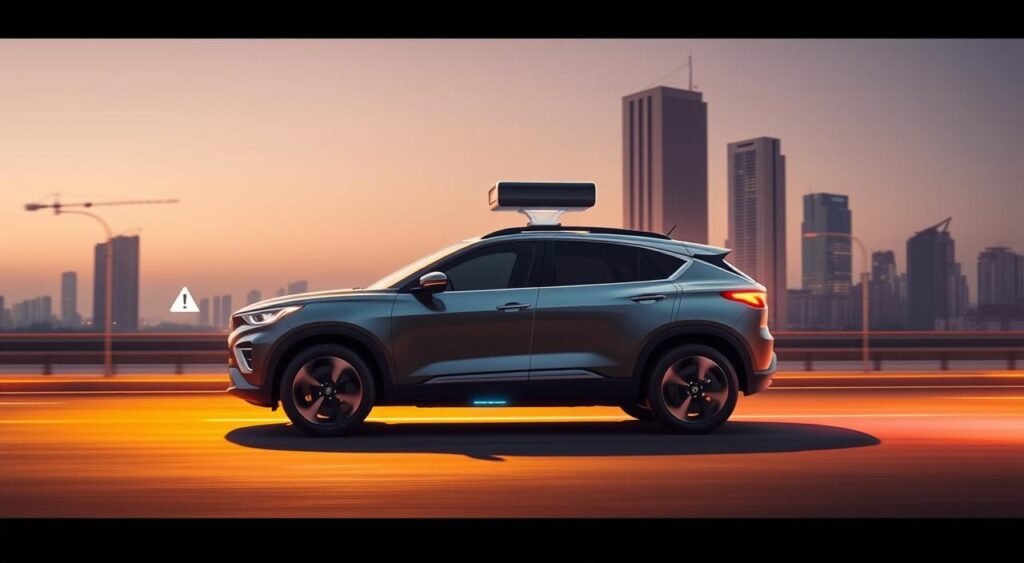
The Harrier EV’s safety suite includes top features found in luxury electric cars:
| Feature | Description |
|---|---|
| Automatic Emergency Braking | Detects and stops for collisions |
| Lane Departure Warning | Notifies you if you’re drifting out of your lane |
| Adaptive Cruise Control | Keeps a safe distance from the car in front |
| Blind Spot Monitoring | Alerts you to vehicles in your blind spot |
The 2025 Tata Harrier EV leads the Indian electric SUV market with its smart features. It offers peace of mind and a better driving experience for everyone.
Feature 5: Updated Interior and Comfort Enhancements
The Tata Harrier EV is set to improve your driving experience. It comes with many comfort features to stand out in the electric SUV market. It has a panoramic sunroof, ventilated seats, and dual-zone climate control, just like the diesel version. But, it also has special features that make it unique.
Comfort Features to Compete in the EV Market
The Harrier EV is designed to win over EV buyers. It offers:
- Powered tailgate for easy access
- Panoramic sunroof for a better driving feel
- Ventilated and powered front seats for comfort
- Dual-zone climate control for your own temperature
- Air purifier for cleaner air inside
- Wireless charger for easy phone charging
How Interior Changes Compare to Regular Harrier
The Harrier EV has many features like the diesel version. But, it introduces Boss Mode for more comfort. This feature lets second-row passengers fold the front seat for more legroom. Here’s a comparison of the interior differences:
| Feature | Harrier EV | Regular Harrier |
|---|---|---|
| Boss Mode | Yes | No |
| Ventilated Seats | Front and Rear | Front Only |
| Panoramic Sunroof | Standard | Optional |
| Wireless Charger | Multiple Locations | Single Location |
The Tata Harrier EV focuses on comfort and convenience. It aims to set a new standard for electric SUVs, making driving more enjoyable.
The Importance of Regenerative Braking
The 2025 Tata Harrier EV has a top-notch regenerative braking system. This tech boosts the car’s efficiency and range extension. It’s key for better daily driving.
How Regenerative Braking Works
Regenerative braking turns deceleration energy into electricity. This electricity recharges the EV’s battery. It’s a smart way to save energy, unlike traditional brakes that lose it as heat.
The Tata Harrier EV has a four-level regenerative braking system. Drivers can adjust it to their liking. They can use the infotainment system or buttons on the steering wheel.
Benefits for Daily Driving
In city driving, regenerative braking shines. It captures energy during stops and starts. This means less need for charging and less range anxiety.
It also makes the EV more efficient and saves the brakes. This could mean longer brake life and lower maintenance costs. Here’s a comparison:
| Feature | Tata Harrier EV | Regular Tata Harrier |
|---|---|---|
| Range Extension (City Driving) | Up to 15% | N/A |
| Brake Wear Reduction | Up to 30% | N/A |
As electric cars become more common, regenerative braking will be key. The Tata Harrier EV leads with its advanced system. It offers a greener and more efficient drive.
Pricing Expectations and Market Positioning
The electric vehicle market is growing fast, and the 2025 Tata Harrier EV is making waves. People are excited to see how it will compare in price to other cars. The regular Harrier diesel starts at Rs 15 lakh and goes up to Rs 26.50 lakh, depending on the trim.
The Harrier EV will come in three versions: Adventure, Fearless, and Empowered. The Adventure trim will start at Rs 21.49 lakh, a bit more than the base diesel. The price of the Empowered trim is not yet known, but it’s expected to be higher than the top diesel model.
Tata is making a big promise to make the Harrier EV more appealing. They’re giving it a lifetime battery warranty. This is a big plus for buyers worried about the costs of electric cars over time.
Competitive Landscape Against Other EVs
The Tata Harrier EV will face tough competition from other electric SUVs. It needs to offer great features and prices to stand out. As more brands enter the EV market, the Harrier EV must be competitive.
With the Adventure trim’s price already out, buyers can start to see what the Harrier EV offers. As more info comes out, people will get a better idea of how it compares to others in terms of price, range, and features.
Consumer Reactions and Expert Opinions
As the 2025 Tata Harrier EV’s release date approaches, consumer feedback is flooding online forums and social media. Automotive fans are excited to see how Tata’s new electric SUV will compare to others.
Enthuasiasts Excited About the Harrier EV’s Features
Potential buyers are loving the Harrier EV’s new features and tech. They also appreciate Tata’s focus on being eco-friendly. Some top features include:
- The larger infotainment screen
- The 540-degree camera system
- Autonomous driving capabilities
Insights from Automotive Experts
Industry analysis shows the Harrier EV’s features will appeal to many buyers. As electric vehicle interest grows, experts are impressed by Tata’s EV entry. Yet, they note the SUV’s success hinges on its price and how it performs in real life.
Reviews and opinions are pouring in, showing the 2025 Tata Harrier EV is a hit. Its advanced features and green design are set to shake up the Indian car market.
Conclusion: Final Thoughts on the 2025 Harrier EV
Tata Motors is making big strides in electric vehicles with the 2025 Harrier EV. This model is a key step towards making cars more eco-friendly. It shows Tata’s dedication to creating top-notch electric cars for Indian drivers.
What Consumers Can Look Forward To
The 2025 Tata Harrier EV is set to be a game-changer for electric car buyers. It will have a longer range, the latest tech, and a green design. This car aims to make driving smooth and fun, blending power, comfort, and eco-friendliness.
The Future of Tata’s Electric Vision
Tata Motors is not stopping in their quest for electric car excellence. The Harrier EV is just the start of many new models. Tata is focused on innovation and design that puts customers first. They’re leading the way to a greener future in India, with electric cars at the forefront.
FAQ
How does the Tata Harrier EV differ from the regular Harrier in terms of exterior design?
The Harrier EV looks almost the same as the regular Harrier. It has a closed-off grille and new bumpers. You’ll also see EV badging and aero wheels. It’s 2mm longer and 22mm taller than the diesel version.
What are the key advantages of the Harrier EV over the regular Harrier?
The Harrier EV has many benefits. It comes with advanced tech and a better range. It also has a top-notch infotainment system and uses sustainable materials. Plus, it offers smart autonomy and improved interior comfort.
How does the infotainment system in the Harrier EV compare to the regular Harrier?
The Harrier EV has a bigger 14.53-inch touchscreen. It uses a Samsung Neo QLED display for clearer images. It also has Boss Mode and a digital IRVM with dashcam.
What are the autonomous driving capabilities of the Harrier EV?
The Harrier EV has some cool autonomous features. It can auto park and has a summon mode. It also has a 540-degree camera view for tight spaces and off-road driving.
How does regenerative braking benefit the Harrier EV’s performance?
The Harrier EV’s regenerative braking is a game-changer. It turns deceleration into electricity to recharge the battery. This boosts efficiency and extends the driving range, perfect for city driving.
What is the expected pricing of the 2025 Harrier EV compared to the regular Harrier?
The Harrier EV’s Adventure trim starts at Rs 21.49 lakh. The top Empowered trim will likely cost more than the regular Harrier. The regular Harrier’s price ranges from Rs 15 lakh to Rs 26.50 lakh across 16 trims.
What are automotive experts saying about the proposed features of the Harrier EV?
Experts think the Harrier EV’s features will draw in buyers. They mention the large infotainment screen, 540-degree camera, and autonomous tech. They say this will appeal to those interested in electric vehicles.
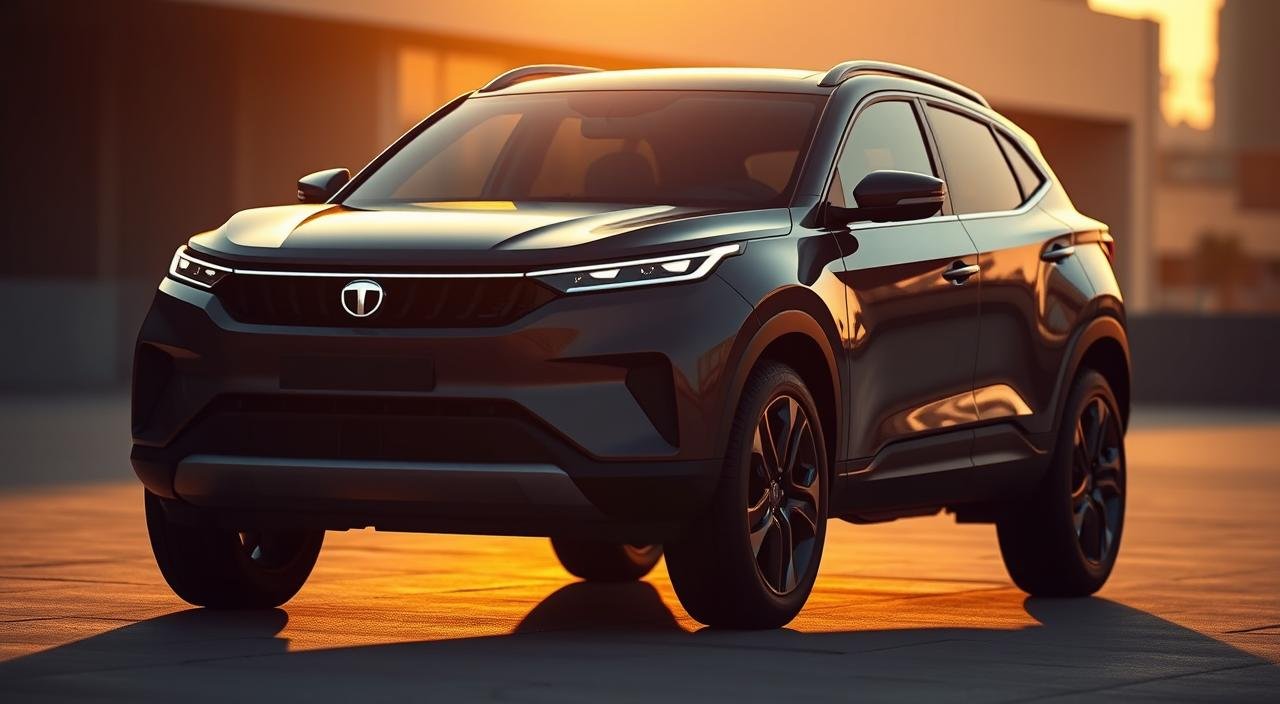
Jun
Are you wondering what sets the Tata Harrier EV apart from the regular Harrier? The buzz around the new Mahindra Bolero 2025 is huge, but Tata’s electric SUV is also getting attention. The EV version has cool features that the regular Harrier doesn’t. It’s packed with advanced tech and better performance. Is the electric Harrier the top SUV for today’s drivers?
The Tata Harrier EV brings the SUV to a new level with its features. It has a bigger infotainment system for staying connected and fun. The boss mode lets you control it from the back seat. You also get a digital IRVM for a clear view behind and a 540-degree camera for full visibility.
With summon mode, your Harrier EV can come to you! Auto park assist makes parking easy. Plus, it has special EV features like V2V and V2L for more uses.
Key Takeaways
- Tata Harrier EV offers unique features compared to the regular Harrier
- Advanced tech includes a larger infotainment system, boss mode, and digital IRVM
- 540-degree camera and auto park assist enhance visibility and convenience
- Summon mode allows the Harrier EV to come to you
- EV-specific functions like V2V and V2L provide added versatility
Introduction to Tata Harrier Models
The Tata Harrier is a hit in India, loved for its sleek design, comfy interior, and strong performance. With the upcoming Mahindra Bolero model in 2025, Tata Motors is adding diesel and electric Harriers. This meets the needs of many customers.
Overview of Tata Harrier
Launched in 2019, the Tata Harrier is built on the OMEGA Arc platform, inspired by Land Rover’s D8. It has a roomy cabin, top-notch features, and a smooth ride. The Harrier’s main specs are:
| Specification | Details |
|---|---|
| Engine | 2.0L Kryotec Diesel |
| Power | 168 bhp @ 3750 rpm |
| Torque | 350 Nm @ 1750-2500 rpm |
| Transmission | 6-speed Manual / Automatic |
| Seating Capacity | 5 Passengers |
Brief Introduction to Tata Harrier EV
The Tata Harrier EV is coming in 2024, as the electric version of the SUV. It will have a big battery and the latest electric tech. This makes it a green choice for those who care about the planet.
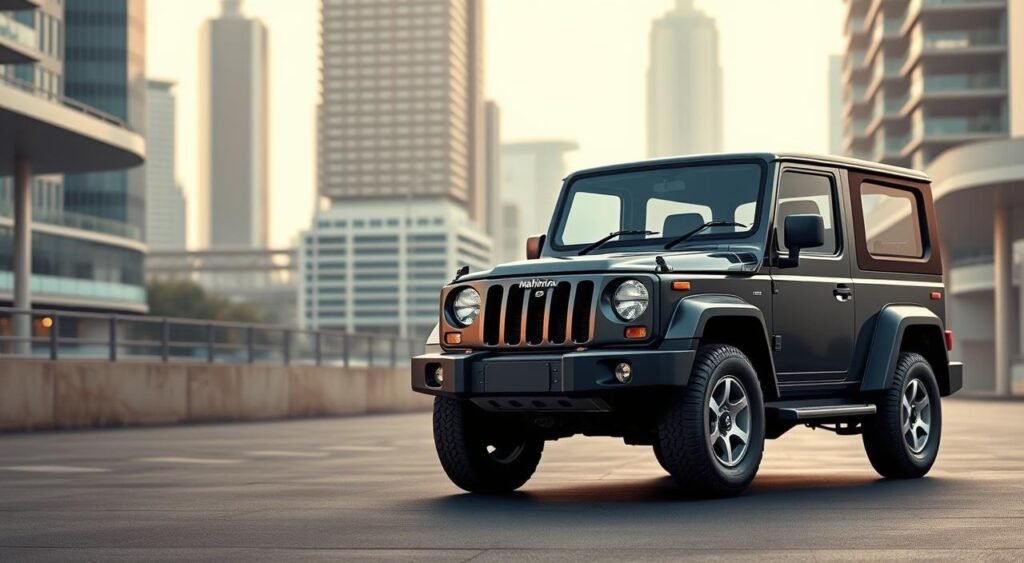
Importance of EV Technology
Electric cars are becoming more popular because they’re good for the environment and save money. The Tata Harrier EV shows how important EVs are getting in the car world. As more people choose electric, car makers like Tata are working hard to make better EVs. This helps us move towards a cleaner, greener future.
Performance Comparison: EV vs Regular
The Tata Harrier EV and the regular Harrier offer different driving experiences. The electric version has instant torque and quick acceleration. This makes it exciting for those who love a thrilling drive.

Acceleration and Torque Differences
The Harrier EV accelerates from 0 to 100 km/h in just 7 seconds. Its electric motor provides instant torque for a smooth, powerful start. In contrast, the regular Harrier, with a 2.0-liter diesel engine, takes about 10 seconds to reach the same speed.
Driving Range of the Harrier EV
The driving range is a key factor for electric vehicles. The Tata Harrier EV has two battery options. The base model offers up to 350 km on a single charge. The higher-end model has a range of 627 km, certified by MIDC.
Fuel Efficiency of Regular Harrier
The regular Harrier is fuel-efficient, despite not being electric. Its 2.0-liter diesel engine gets around 16 km/l in the city and up to 20 km/l on highways. This makes it a cost-effective choice for those who prefer traditional engines.
As Mahindra Bolero prototype spotted testing shows, car makers are working on both electric and traditional engines. Whether you want fast acceleration and eco-friendliness or long-distance driving and fuel savings, the Tata Harrier lineup has something for everyone.
Design Elements: Aesthetic Changes
The Tata Harrier EV and its regular version share a similar design. But, the electric version has unique exterior features that make it stand out. The 2025 Bolero rumors are exciting, but the Harrier EV is already making a splash with its looks.

Exterior Features of the Harrier EV
The Harrier EV has a closed-off grille for a sleek look. Its bumpers are updated for better aerodynamics. It also has special alloy wheels that are stylish and improve its performance.
Interior Styling and Comfort
Inside the Harrier EV, you’ll see a layout similar to its regular sibling. But, it has a bigger 14.53-inch infotainment screen for a better multimedia experience. It also has extra comfort features, like boss mode for more legroom in the back.
Unique Color Options Available
The Tata Harrier EV comes in exciting colors:
- Sparkle Blue
- Copper Bronze
- Pristine White
- Midnight Black
These colors make the Harrier EV eye-catching on the road. They appeal to eco-conscious buyers. As people wait for the Mahindra Bolero test drive, the Harrier EV’s colors are already drawing attention.
Technology and Infotainment Comparison
The Tata Harrier EV is a step up from the regular Harrier in tech and infotainment. It has an advanced system called TiDAL. This system allows for cool features like OTA updates, voice commands, and a 540-degree camera system.
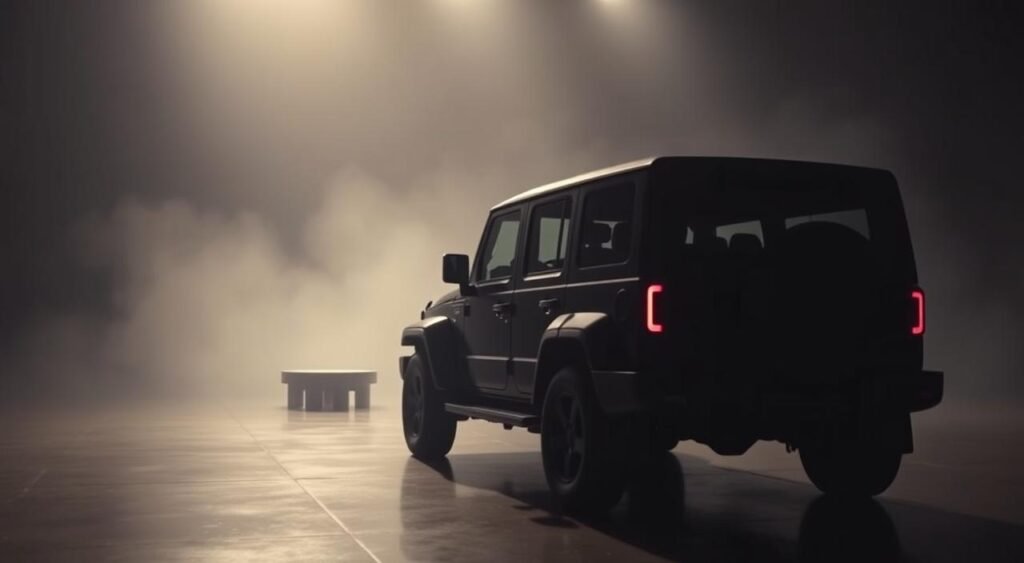
The Harrier EV also has Level 2 ADAS for better safety and convenience. It has a digital rear view mirror, automatic park assist, and a summon mode. This mode lets you call the car to you with your phone.
Connectivity Features in Each Model
Both Harrier models have connectivity features for fun and info on the move. They include:
- Connected car tech with remote access
- Wireless Android Auto and Apple CarPlay
- Built-in navigation
- Premium audio system
Integrated Safety Technologies
Tata Motors focuses on safety in both Harrier models. The EV has more advanced safety features like:
| Harrier EV | Regular Harrier |
|---|---|
| Level 2 ADAS | Electronic Stability Program (ESP) |
| 540-degree surround view | Rear parking sensors |
| Digital IRVM with dashcam | Dual front airbags |
| Auto park assist and summon mode | ABS with EBD |
User Interface and Experience
The Tata Harrier EV has a modern interface with a large touchscreen. It controls all infotainment and settings. The regular Harrier also has a user-friendly interface but is less advanced.
The Harrier EV leads in tech and infotainment, making driving better and keeping you connected. Yet, both models offer great connectivity and safety features for today’s drivers.
Battery and Charging Infrastructure
The Tata Harrier EV has top-notch battery tech. It offers great capacity and charging options for a smooth drive. With more EV charging stations popping up, driving an electric car like the Harrier EV is easier than ever.

Battery Capacity of the Harrier EV
The Tata Harrier EV has two battery packs: 65 kWh and 75 kWh. These batteries give the car lots of power and range. The Lithium Iron Phosphate tech makes the battery safe and stable, perfect for the Mahindra Bolero 2025.
Charging Options and Times
Tata gives Harrier EV owners several charging choices. The time it takes to charge depends on the charger type:
- 7.2 kW AC Charger: A full charge takes about 10.7 hours
- 120 kW DC Fast Charger: Charges 20-80% in just 25 minutes
These options let Harrier EV owners charge at home or public stations. It’s easy to keep the battery charged for daily drives or long trips.
Benefits of EV Charging Stations
India’s growing EV charging stations are a big plus for electric car owners. These stations offer many benefits:
- Convenience: Find and use charging points easily with apps or car systems
- Fast Charging: Quick top-ups are available for long drives
- Cost-effective: Charging at public stations is cheaper than gas cars
As more EV charging spots appear, owning an EV like the Tata Harrier EV is more appealing. It’s great for those who care about the environment and want a reliable, efficient car.
Sustainability and Environmental Impact
The Tata Harrier EV is a big step towards a greener future. More people now think about how their cars affect the planet. The Harrier EV is a great choice for those who care about the environment, thanks to its low emissions.
Emissions Reduction with the EV
The Tata Harrier EV cuts down on carbon emissions a lot. Electric cars don’t have tailpipe emissions like gas cars do. So, driving the Harrier EV makes the air cleaner and helps our health.
When the Mahindra Bolero 2025 price is out, the Harrier EV will be an even better choice for those who want to help the planet.
Recycling and Sustainability Initiatives
Tata Motors works hard to make their cars better for the environment. They focus on recycling and using materials that can be reused. By choosing the Harrier EV, you support a company that cares about the planet.
The Future of Eco-Friendly Driving
Electric cars like the Tata Harrier EV are the future of driving. They’re getting better with new battery tech and more charging spots. Choosing electric cars helps us all live in a cleaner world.
The Mahindra Bolero 2025 is coming, but the Tata Harrier EV is already leading the way in India.
Cost of Ownership: EV vs Regular
Looking at the Tata Harrier EV and its regular version, we see a difference in cost over time. The initial price is not the only thing to consider. Maintenance costs and resale value are also key to the overall cost.
Purchase Price Comparison
The Tata Harrier EV costs more at first than the regular Harrier. The electric version starts at Rs 21.49 lakh (ex-showroom). But, electric cars can save money in the long run.
Maintenance Costs Over Time
The Tata Harrier EV has lower maintenance costs. Electric cars have fewer parts and no need for oil changes. This means less money spent on upkeep.
| Model | Estimated Annual Maintenance Cost |
|---|---|
| Tata Harrier EV | Rs 5,000 – Rs 8,000 |
| Regular Tata Harrier | Rs 10,000 – Rs 15,000 |
The table shows the Tata Harrier EV can save money on maintenance. This makes it a good choice for those watching their budget.
Resale Value Analysis
The resale value of electric cars is growing in India. As EVs become more common, their value will likely go up. But, the regular Harrier might have a slight edge in resale value now.
Choosing between the Tata Harrier EV and the regular Harrier depends on what you value most. The EV is cheaper to run and better for the environment. But, the regular Harrier is more affordable upfront and might hold its value better in the short term. Looking at the Mahindra Bolero 2025 interior and images, it’s important to think about these costs when deciding.
Driving Experience: Customer Feedback
The Tata Harrier EV has caught the eye of many. People who have driven it share their thoughts. Their feedback helps us understand how it performs in real life.
Test Drive Experiences
Those who’ve driven the Tata Harrier EV love its quick start and smooth ride. It’s quiet and easy to drive, perfect for city or highway. The steering and suspension make it comfortable and stable.
User Reviews and Ratings
Online, people love the Tata Harrier EV. They say it’s roomy and has a great interior. The tech inside is easy to use, and they like how it looks and drives.
Community Insights
A community of fans has grown around the Tata Harrier EV. They talk about its range and how to get the most out of it. Their enthusiasm shows it’s a big deal in India’s electric car market.
More people trying the Tata Harrier EV means more good words. It’s a hit for its looks, comfort, and being green. With happy owners, it’s set to change the car scene in India.
Unique Features of Tata Harrier EV
The Tata Harrier EV has special features that make it stand out. These features improve the driving experience and add advanced technology and safety. This makes the Harrier EV a great choice for those looking for a modern electric vehicle.
Multiple Driving Modes
The Tata Harrier EV has different driving modes for various situations:
- Eco Mode: Saves energy for better efficiency
- City Mode: Balances performance and efficiency for city driving
- Sport Mode: Shows off the electric powertrain for a fun drive
- Boost Mode: Gives extra power for quick maneuvers
Innovative Tech Features
The Harrier EV offers advanced tech for comfort and convenience:
| Feature | Description |
|---|---|
| DrivePay | A UPI-based in-car payment system for easy transactions |
| Boss Mode | Powered seats for second-row passengers, adding luxury |
| Cooled Storage | A sliding armrest with a cooled compartment for drinks and snacks |
Advanced Safety Mechanisms
- Off-Road Assist: Improves traction and stability on rough terrains
- Transparent Mode: Gives a virtual view of the road, helping with obstacles
- 360-Degree Camera: Offers a bird’s eye view for easy parking and maneuvering
The Tata Harrier EV has unique driving modes, tech features, and safety measures. It offers a modern and safe driving experience, making it different from the regular Harrier and other vehicles.
Conclusion: Which Harrier is Right for You?
Choosing between the Tata Harrier EV and the regular Harrier depends on what you need. The Harrier EV is great for those who love tech and want to be eco-friendly. It has cool features and doesn’t pollute, making it perfect for the modern driver.
The regular Harrier is a good pick for those watching their budget. It runs on diesel and is known for being reliable. It’s a solid choice for those who like the old-school way of driving.
Key Takeaways
The Tata Harrier EV and the regular Harrier both perform well in their own ways. The EV gives you quick power and smooth rides. The regular Harrier has strong power and is good for long trips.
Both Harriers focus on keeping you safe. They come with advanced safety features and are built to last. This is similar to what we can expect from the Mahindra Bolero 2025.
Final Thoughts on Performance
Choosing between the Tata Harrier EV and the regular Harrier depends on your lifestyle. If you want something new and green, the EV is for you. But if you’re looking for something more affordable, the regular Harrier is a solid choice.
Selecting Based on Lifestyle Needs
It’s all about what you need and want. If you care about the planet and want the latest tech, go for the EV. But if you’re on a budget and like the traditional way of driving, the regular Harrier is a great option.
Think about how you drive, your daily commute, and what you want in the long run. This will help you choose the right Harrier for you, just like you would with the Mahindra Bolero 2025.
FAQ
What are the main differences between the Tata Harrier EV and the regular Harrier?
The Tata Harrier EV and regular Harrier have different features and performance. The EV has a bigger infotainment system and boss mode. It also has a 540-degree camera and auto park assist.
The EV has EV-specific functions like V2V and V2L. The regular Harrier has a 2.0-liter diesel engine with 170 hp and 350 Nm of torque.
How does the performance of the Tata Harrier EV compare to the regular Harrier?
The Harrier EV has impressive performance with its electric powertrain. It offers instant torque and quick acceleration. The EV has a range of up to 627 km.
In contrast, the regular Harrier has a 2.0-liter diesel engine with 170 hp and 350 Nm of torque.
Are there any exterior design differences between the Tata Harrier EV and the regular Harrier?
The Harrier EV and regular Harrier share a similar design. The EV has a closed-off grille and unique alloy wheels. The interior is mostly the same, but the EV has a larger infotainment screen.
The EV also has boss mode for more comfort.
What advanced technology features are available in the Tata Harrier EV?
The Harrier EV has advanced technology like a new electrical architecture (TiDAL). It enables OTA updates and voice commands. It also has a 540-degree surround view and Level 2 ADAS.
The EV has a digital IRVM with a built-in dashcam and auto park assist. It also has summon mode.
What are the battery options and charging times for the Tata Harrier EV?
The Tata Harrier EV has two LFP battery pack options: 65 kWh and 75 kWh. Charging times vary. A 7.2 kW AC charger takes 10.7 hours for a full charge.
A 120 kW DC fast charger can charge to 80% in 25 minutes.
How does the Tata Harrier EV contribute to reducing environmental impact?
The Tata Harrier EV reduces carbon emissions and promotes eco-friendly driving. Electric vehicles produce zero tailpipe emissions. This makes them a cleaner alternative to traditional vehicles.
Tata Motors is investing in recycling and sustainability. They aim to minimize environmental impact throughout a vehicle’s life cycle.
What is the cost difference between the Tata Harrier EV and the regular Harrier?
The Tata Harrier EV costs more than the regular Harrier. The entry-level Adventure trim starts at Rs 21.49 lakh (ex-showroom). Electric vehicles have lower maintenance costs.
They have fewer moving parts and no need for regular oil changes.
What are customers saying about their experience driving the Tata Harrier EV?
Customers love the Harrier EV’s instant torque and smooth acceleration. They also appreciate its quiet operation. User reviews highlight the EV’s advanced features and comfortable interior.
The Harrier EV community is growing. Owners share their experiences and insights on various platforms.
What unique features does the Tata Harrier EV offer compared to other EVs?
The Tata Harrier EV has unique features like multiple driving modes. It also has a UPI-based in-car payment system (DrivePay). The EV offers advanced safety features like off-road assist and transparent mode.
It provides enhanced comfort with features like a powered boss mode. It also has a sliding armrest with cooled storage.
How do I decide between the Tata Harrier EV and the regular Harrier?
The Tata Harrier EV and regular Harrier meet different needs and preferences. The EV offers advanced technology and eco-friendly credentials. It’s suitable for tech-savvy buyers who value sustainability.
The regular Harrier has a diesel engine and lower price. It may appeal to customers who prioritize affordability and have concerns about EV charging infrastructure. The choice depends on individual lifestyle needs, budget, and access to charging facilities.

Jun
Is the Kia Carens Clavis Electric Vehicle coming soon? Kia India has given hints that this wait might end sooner than we thought. The excitement is growing as the July 2025 debut of the Kia Carens Clavis EV draws near. Let’s explore what we know about this innovative electric car from Kia.
The Kia Carens Clavis EV is making waves globally and in India. Spy shots show it looks a lot like its gasoline version. Kia’s latest news in May 2025 has sparked more rumors about its release. It seems the Kia Carens Clavis EV is set to shake up the Indian electric car scene.
Key Takeaways
- Kia India hints at July 2025 launch for Kia Carens Clavis Electric Vehicle
- Spy shots reveal design similarities to recently launched ICE version of Carens Clavis
- Press release for May 2025 suggests imminent debut of Kia Carens Clavis EV
- Anticipation builds for game-changing electric car from Kia in India
- Kia Carens Clavis EV expected to significantly impact Indian EV market
What is the Kia Carens Clavis EV?
The Kia Carens Clavis EV is a new electric vehicle from Kia. It combines the practicality and comfort of the Carens with eco-friendliness for families.
Overview of the Kia Carens Clavis EV
The Kia Carens Clavis EV looks similar to its gas-powered sibling but with EV tweaks. It has a sleek, blanked-off grille and a charging port in the middle. It also has aerodynamic wheels to improve range and efficiency.

Key Features to Expect
The Carens Clavis EV comes with many impressive features, including:
- Spacious 6- and 7-seater configurations
- Cutting-edge battery technology for extended range
- Fast charging capabilities for convenience
- Advanced driver assistance systems for enhanced safety
- Intuitive infotainment system with seamless connectivity
These specs show Kia’s dedication to making a great electric family car.
Target Market and Positioning
The Kia Carens Clavis EV is for families wanting a spacious, eco-friendly MPV. It has a stylish design, a practical interior, and the latest tech. It’s ready to compete with other electric family cars.
As families focus more on being green, the Carens Clavis EV is a great choice. It offers comfort and convenience without harming the environment.
Anticipated Release Date
Car fans are excitedly waiting for the Kia Carens Clavis EV to hit the market. There’s a lot of talk about when it will arrive. Kia hasn’t shared an exact date yet, but experts are studying Kia’s recent statements for clues.

Many think the Kia Carens Clavis EV will debut in July 2025. This fits with Kia’s plans to grow their electric car lineup. It also meets the rising need for green cars.
Timeline for Launch
Kia’s recent press release hints at a July 2025 debut. It says, “Carens Clavis makes a strong debut, setting the stage for the company’s next innovation in July.” This has fans buzzing with excitement, counting down the days.
Factors Influencing Release Dates
The July 2025 date looks likely, but many things can change it. These include:
- Production and supply chain logistics
- Regulatory approvals and certifications
- Market demand and competition
- Technological advancements and refinements
Kia is known for keeping their promises. This makes many think the Carens Clavis EV will arrive on time. Fans and buyers are watching Kia for any updates on the exact launch date.
Technology and Specifications
The Kia Carens Clavis EV is packed with cutting-edge tech and impressive specs. It promises a smooth drive, blending eco-friendliness with top-notch features.
Battery and Range Highlights
The battery and range are key for electric vehicles. The Kia Carens Clavis EV will have various battery packs for different needs. It might use the same 51.4kWh and 42kWh batteries as the Creta Electric, giving a range of 400-500 km on one charge. This means long trips without needing to stop for a charge often.
Infotainment and Connectivity Features
The interior of the Kia Carens Clavis EV boasts a high-tech infotainment system. It will have dual 12.3-inch screens for a modern look. These screens will handle everything from navigation to entertainment, keeping you connected and entertained.
It might also have a panoramic sunroof and ambient lighting. These features add to the luxury and immersive feel of the interior.
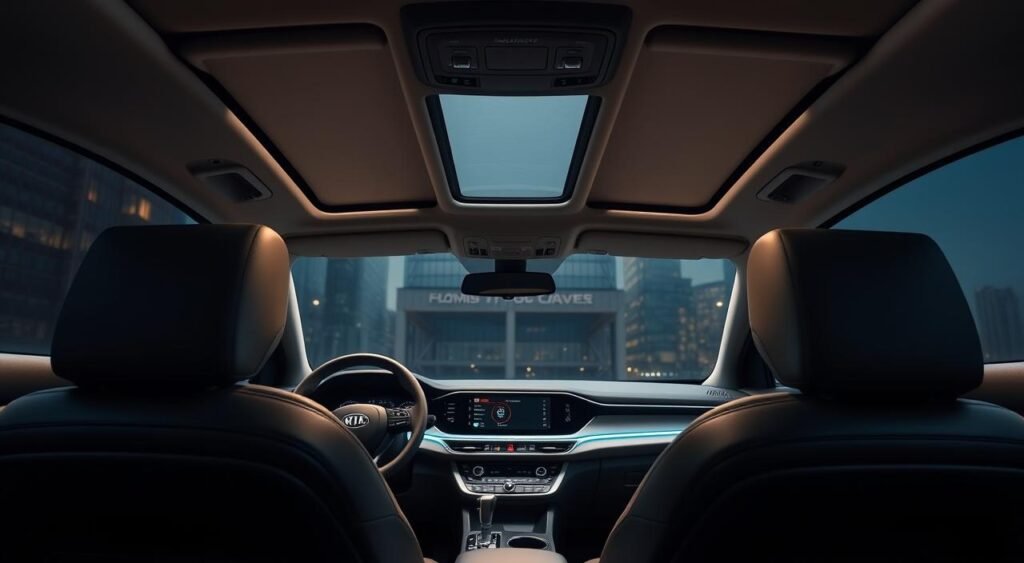
Safety Innovations
Kia prioritizes safety, and the Carens Clavis EV is no exception. It’s expected to have advanced safety features like ADAS. This includes lane departure warning, forward collision warning, and adaptive cruise control.
These systems aim to make driving safer by alerting the driver to possible dangers. The vehicle might also have six airbags for extra protection in crashes. A 360-degree camera system could be available, making parking easier.
The Kia Carens Clavis EV might also have special EV features. It could support Vehicle-to-Load (V2L) and Vehicle-to-Vehicle (V2V) charging. This lets it power external devices or even charge other electric vehicles. These features add to the vehicle’s convenience and versatility.
| Feature | Description |
|---|---|
| Battery Options | 51.4kWh and 42kWh units |
| Range | 400-500 km on a single charge |
| Infotainment | Dual 12.3-inch displays |
| Safety Features | ADAS, six airbags, 360-degree camera |
| EV-specific Tech | V2L and V2V charging support |
Pricing and Variants
The Kia Carens Clavis EV is coming to India soon. People want to know the price and what trim levels will be available. Kia plans to price it competitively, but details are not out yet.
Expected Pricing Strategy
The Kia Carens Clavis EV is expected to start at around Rs 16 lakh (ex-showroom). This makes it a great choice for families wanting to go green. It has a big interior, cool features, and is electric, making it a strong contender in its class.
Available Trim Levels
Kia offers different versions of their cars to meet various needs and budgets. The Carens Clavis EV will likely have:
- Base Variant: It has the basics and a comfy interior.
- Mid Variant: Adds more comfort and tech, like a big screen and rear AC vents.
- Top Variant: It’s the most loaded, with a sunroof, wireless charging, and safety tech.
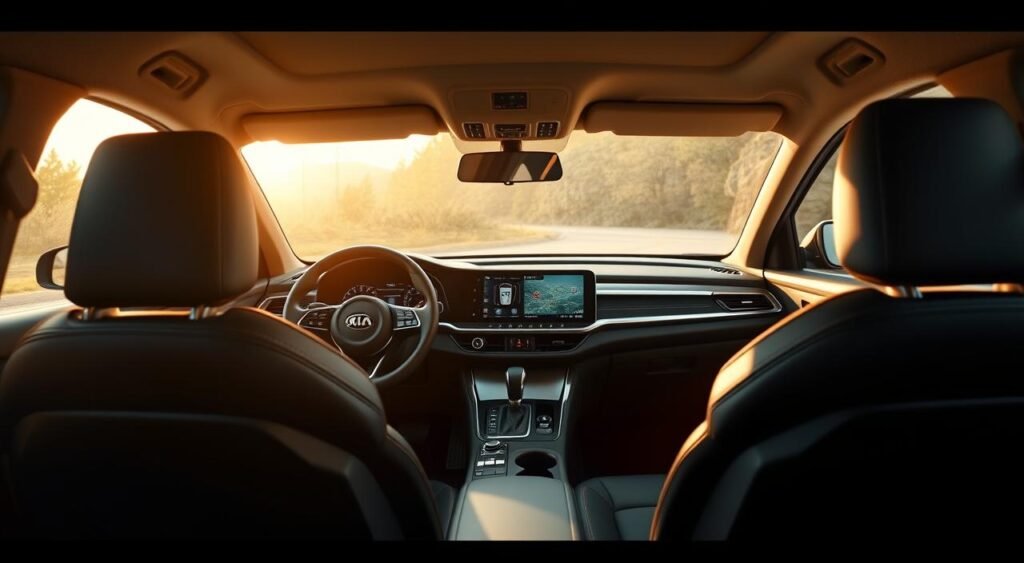
Comparison with Competitors
The Kia Carens Clavis EV will face off against the BYD eMax 7 in India. It also offers an electric option for fans of the Toyota Innova Hycross and the upcoming Maruti Invicto. Here’s how it compares:
| Vehicle | Expected Price (ex-showroom) | Key Features |
|---|---|---|
| Kia Carens Clavis EV | Rs 16 lakh onwards | Electric powertrain, spacious interior, advanced features |
| BYD eMax 7 | Rs 18 lakh onwards | Electric powertrain, premium interior, long-range battery |
| Toyota Innova Hycross | Rs 17 lakh onwards | Hybrid powertrain, spacious interior, reliable brand |
| Maruti Invicto | Rs 15 lakh onwards (expected) | Petrol engine, premium features, Maruti’s wide service network |
Market Reception and Expectations
As the Kia Carens Clavis EV gets ready to hit the Indian market, everyone is excited. This all-electric MPV combines eco-friendliness with family-friendly features. It’s making a big splash with consumers.
Initial Reactions from Experts
Industry experts are feeling good about the Kia Carens Clavis EV’s chances in India. They think its good price, roomy interior, and cool features will draw in families. They see it as a reliable and efficient electric car choice.
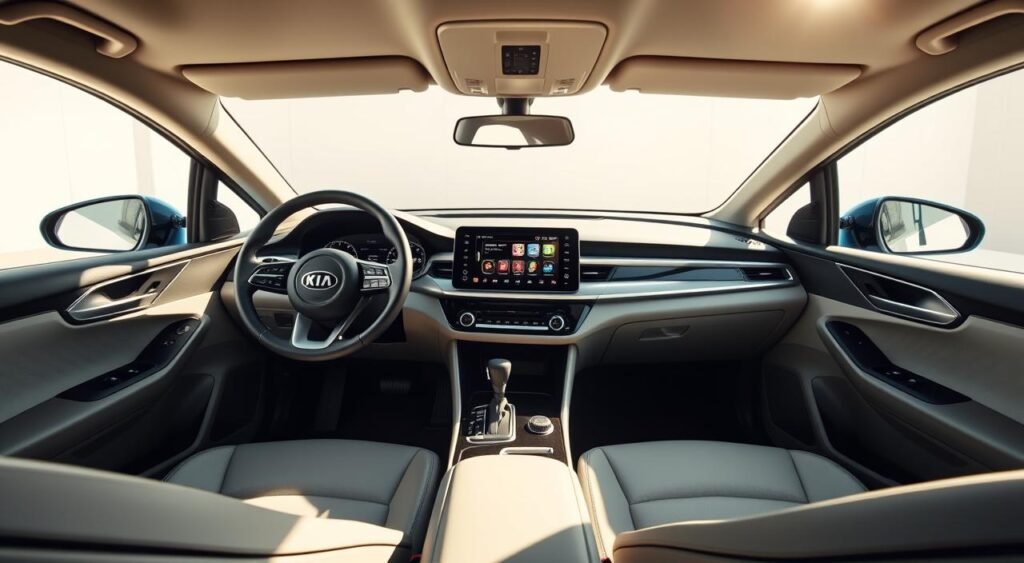
Expected Consumer Interest
The Kia Carens Clavis EV is set to grab the interest of many in India. It’s aimed at young families, city workers, and those who care about the planet. It offers comfort and convenience without giving up on sustainability.
Early Reviews and Feedback
Even though it’s not out yet, early reviews of the Kia Carens Clavis EV are positive. Test drivers love its smooth ride, lots of room, and easy-to-use tech. It looks like it could be a big hit in the Indian electric car market.
As the launch gets closer, people are getting even more excited. Kia is known for making quality cars that are easy on the wallet. This is adding to the buzz around the Kia Carens Clavis EV.
Conclusion
The Kia Carens Clavis EV is set to change the electric MPV market. It combines practicality, affordability, and advanced features. This makes it appealing to many, including families who want an eco-friendly car.
Summary of Key Points
The Clavis EV has many great features. It has a strong battery, advanced tech, and safety features. It’s expected to launch in July 2025 and will be priced well, making it a strong choice in the electric car market in India.
Final Thoughts on the Kia Carens Clavis EV
The Kia Carens Clavis EV is a big step towards electric cars. It’s practical, affordable, and packed with the latest tech. This makes it a great choice for those wanting a sustainable car without giving up on features or performance.
Kia is ready to take a big share of the electric car market in India. The Carens Clavis EV is a key part of this plan, helping more people switch to electric vehicles.
FAQ
What is the Kia Carens Clavis EV?
The Kia Carens Clavis EV is the electric version of the Kia Carens Clavis MPV. It will have a design similar to the ICE version. It will have EV-specific features like a blanked-off grille and aero-specific alloy covers.
When is the Kia Carens Clavis EV expected to launch?
The Kia Carens Clavis EV is set to launch in July 2025. The price will be announced after its unveiling. Kia has hinted at this timeline in a recent press release.
What are the expected battery and range specifications of the Kia Carens Clavis EV?
The Kia Carens Clavis EV will have different battery packs. It might use the 51.4kWh and 42kWh units from the Creta Electric. It’s expected to have a range of 400-500 km.
What features can we expect in the Kia Carens Clavis EV?
The Kia Carens Clavis EV will have dual 12.3-inch displays and a panoramic sunroof. It will also have ambient lighting, ADAS, and six airbags. It might include EV-specific tech like V2L and V2V charging.
What is the expected price range of the Kia Carens Clavis EV?
The Kia Carens Clavis EV is expected to cost around Rs 16 lakh (ex-showroom). It will be a family-friendly electric MPV. It will compete with the BYD eMax 7 and serve as an electric alternative to the Toyota Innova Hycross and Maruti Invicto.
What is the target market for the Kia Carens Clavis EV?
The Kia Carens Clavis EV is for families wanting a practical electric MPV. With its features and price, it aims to increase electric vehicle adoption in India.
